#Local vs. Global Businesses
Explore tagged Tumblr posts
Text
Why Do Consumers Prefer Local Businesses Over Large Retailers?

The global pandemic has had a significant impact on the retail industry in a number of ways. In 2020, the retail industry has undergone significant transformations due to supply chain challenges, accelerated digital and omnichannel activities, and significant transformations in consumer buying behavior.
Many small companies were obliged to come up with imaginative strategies and local marketing tips to keep their doors open due to the pandemic’s financial and other restrictions. Because of our recession-resistant business model, our retail franchises have been able to prosper despite the market’s shifts. Many consumers were cautious to buy in 2020 because they had to reevaluate how they live and what they value. Despite the fact that consumers’ focus has switched to health and well-being, they have stayed loyal to the brands they know and appreciate, which for many means shopping at their neighborhood stores.
In terms of the local economy, local firms have a greater impact.
Compared to chain retailers, locally owned firms are more likely to reinvest their profits back into the community. Local company owners are more likely to buy from local firms, according to research. As a result, there is a sense of friendship and mutual trust between local company owners.
Local businesses tend to be smaller, and their proprietors are more accessible. The owners and/or staff of many small local businesses form an integral aspect of the company’s identity. As the company and its brand become less abstract, it becomes easier to form a personal connection with them. Because these firms are tangible and share a common understanding, the camaraderie and trust amongst local company owners grow.
There is more to the local economy than just the reinvestment of money back into the community. As local businesses expand, they create additional local jobs. As a result, money is constantly moving between local companies and residents. In some industries, local enterprises may even pay and benefit their employees more generously than their larger counterparts.
Local Businesses Can Fortify a Community
As a result of forming an economic and social web, locally owned businesses help to strengthen local economies and revitalize downtown areas. Buying from a local business supports the local economy and allows for more personal connections.
Local businesses may not have as many customers as larger corporations, but this gives them the opportunity to cultivate stronger bonds with their clients. There is a lack of reciprocity in dealings with larger corporations because of this. The relationship between a customer and a brand is one-on-one, but the same cannot be said for the other way around. Yes, there is a relationship between a brand and its customers, but it’s not a one-on-one exchange. Instead of treating Jim as a nameless consumer, local businesses have the option to identify and create a relationship with Jim.
A customer’s emotional attachment to a local business can be bolstered when the business takes advantage of the community’s closeness and local SEO services. A sense of belonging to a small group might result from the specialist nature of local enterprises. Customers may want to tell their friends and relatives about their “little secret” because word-of-mouth is usually the best form of advertisement for small businesses. In this way, a local firm can foster a sense of belonging among its customers and employees. A local business can eventually become a tourist attraction in its own right.

Local Businesses Breed Competition & Innovation
The more established a company is, the less likely it is to do new things. Many times, they must cater to the bulk of their customers because of the size of their market. Because of this, the company may not want to move too far from its core values if things are going well.
Local businesses frequently cater to a certain market and a local market at that. It is becoming increasingly difficult to distinguish between one-of-a-kind firms in an increasingly homogenized society. Local businesses, in contrast to larger corporations, are freer to offer what they want and to customize their products and services to meet the specific needs of their customers. Local companies are owned and operated by the people who live and work in the community they serve. Customers will have more options for goods and services as more local businesses come up.
Local businesses compete with one other, rather than larger firms, on a regular basis, defining the importance of local marketing. As a result of the vast number of local enterprises, competition amongst them might spur long-term innovation. If small businesses don’t keep up with the times by introducing new products and services, it might be difficult for them to remain relevant.
Conclusion
It is essential for a community and its economy to have small enterprises. They deserve our business all year round, not just during the holiday season. Their efforts are numerous and they are well-deserving. If you’re in the market for something new, consider visiting a small shop in your neighborhood rather than going to the mall or large retailers. Local businesses have the advantage of being more accessible to their clients and utilize local marketing and other local businesses because they are located in the heart of the town.
Contact Us
At Reversed Out Creative, we understand the challenges and opportunities presented by AI disruption. Our team of experts specializes in web design, SEO, graphic design, and digital marketing services. Reach out to us through our contact form to learn more about navigating the evolving job market and embracing the potential of AI. Together, let’s shape a future that combines human ingenuity with the power of AI.
Content source: https://reversedout.com/local-businesses-benefits/
#Benefits of Local Businesses#Support Local Businesses#Local Business Impact#Local vs. Global Businesses#Local Business Promotion
0 notes
Text
buying from the global store feels like buying from amazon vs supporting local jorvik business
#I think they should keep the global store but as a catalogue#& it just tells you where to buy it#sso#ssoblr#star stable#star stable online
338 notes
·
View notes
Text
Cultural Capital #1: Intro + The Basics


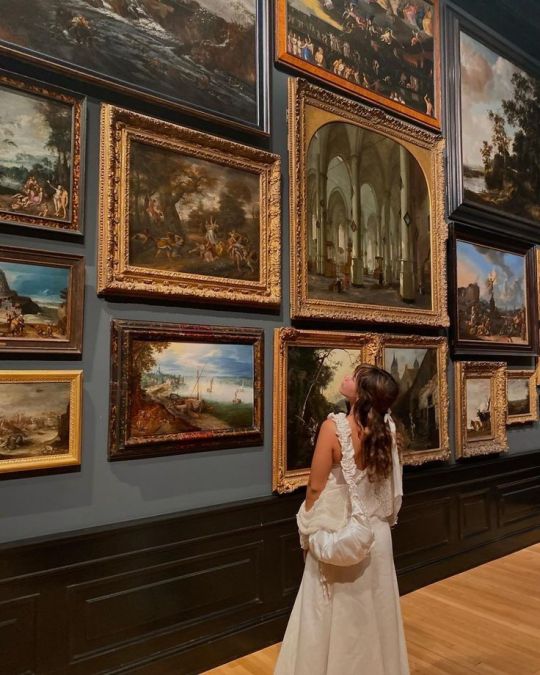
One of the biggest privileges I had growing up was access to cultural capital. My parents were expat teachers, which meant that we had access to a lifestyle well above what we would've had if we had stayed in Australia. I got to travel, meet people from various cultures, go to private school, and I subconsciously absorbed that lifestyle as an expectation. This has given me a huge advantage, and since I don't believe in gatekeeping, here's how you can gain some of that knowledge.
0. A note
Some of these are things I strongly disagree with, but this is the way it is. One shouldn't have to change oneself to get ahead, but we often do. This is just a list of western upper-middle class cultural signifiers, and my listing them out doesn't diminish your own culture if it is different from this. Your own cultural capital is just as valuable as what I'm going to share. But we do live in a world where you can get benefits from knowing the dominant culture's valued information, so this is a guide to hacking that system.
1. What is cultural capital?
When people move to a certain place, be it a neighbourhood or a workplace, they need to understand the language, references, and customs of the people around them, otherwise they might be treated negatively. This is cultural capital. Your ability to fit in with the dominant class and culture can benefit you in work and social situations. Your education, who you know, how you speak and dress, which cultural references you make and understand, etc. are all class signifiers, and contribute to cultural capital.
2. Free ways to gain cultural capital
Confidence and vibe. I'm not the best at this, and there are plenty of resources out there for learning it that would probably be better than me. What I will say is that people can tell when you're used to settling for less, and that lowers your cultural capital in these spaces.
Go to a library or Google for research. Topics to research include: major religious stories and Greco-Roman myths, art and music history - especially from the 16th-19th centuries, different cultures and global geography, common idioms and expressions in French/Latin, jargon for your field as well as those of art/dance/music/business, fancy brand names (Quick, is a Ferragamo a shoe or a car?)
Read literary fiction and non fiction. Making references to classic novels shows rich people that you're well read, which in their minds translates to education and therefore intelligence (which isn't true but you know). It's also a shared experience, which gives you something to talk about. Use Libby for free audiobooks, and your local library for print books.
Expanding your vocabulary and speaking with care. The more you can articulate yourself, the more likely people will be to listen to you.
Going to public museums or galleries (if they have them where you live). They're almost always free, and are a great way to spend a weekend.
Watching videos, reading scripts, or listening to recordings of theatrical performances. These can be pretty easily found on the internet and give you material to reference when talking someone up.
Study philosophy. If you want something accessible and fun, watch The Good Place. Philosophy Tube makes excellent, thought provoking videos for free, and I'm sure there's more out there. Expanding your thought process and recognising the literature out there about 'deep' topics can help you not only seem smarter, but actually be smarter.
Learning to eat politely in multiple cultures. What do you eat with your hands vs a fork vs chopsticks? For western cuisine, you should know which fork to use, how to pour wine, what you do with your napkin, etc.
General etiquette. Handshakes, when and how to hold a door, you get the gist.
3. Ways that cost money
Cook something from a different culture every [week/month]. Expanding your palate and becoming familiar with things outside of your immediate circle will make you more 'cultured' in the eyes of people who care about that.
Special exhibitions and paid museums and galleries. Sometimes, a museum will cost money, and if it's interesting and within your budget, it's well worth it. Museums are an engaging way to learn more about history and culture, which will give you knowledge you could benefit from having.
Going to the theatre. Seeing a play, musical, opera, or ballet, especially if it references mythology or is iconic in its own right, can expand your views on universal themes like love, life, death, and revenge. It's also just really fun. You don't have to spend a huge amount either; see what's available in your area.
Dressing professionally. This means having a baseline knowledge on clothing terms and what fits you well, buying well made clothes that will outlast trends, and keeping them well maintained. Tailoring should be considered if it's in your budget; nobody likes an ill fitting suit. Some tips: second hand shops are a good place to start, avoid fast fashion, and remember that a 20 year old Chanel piece has more cultural capital than a brand new H&M piece.
Grooming. Smelling good, looking put together, and having good hygiene will help you immensely. A perfume that suits you is well worth the money, but don't be afraid of dupes if it's not in your budget.
Travelling. This is by far the most expensive thing on this list, but having those new experiences will completely change your viewpoint in a way that other people can recognise.
4. Signifiers that take a long time/effort
Accents. This matters more in some places than in others, but being able to fake a 'posher' accent gets you privilege in certain contexts. My school taught us only in RP English, but the social circles were run by the US military families, so I have a more neutral accent by default. I can also switch between the two, which gives me an advantage here in Australia, where proximity to an RP accent signifies wealth.
Learning a language. Knowing English automatically gives you a ton of cultural capital, since that's the lingua franca for most fields nowadays. But if English is your first language, knowing more than one means education. The unfortunate double standard is that if English is your second language, you need a third to be considered educated, usually a European language.
Straight teeth. This one is up to luck for some people, but having straight teeth usually means you have the money to straighten them. It also takes years and hurts. In my opinion, it's only worth it if your teeth are causing medical problems in your life, in which case you might as well straighten them while you're at it.
Getting a specialised degree in something. Don't worry about seeming silly (arts, humanities) or cold (business, sciences) when choosing a degree. Someone will be weird about it no matter what you pick, so pick one you like.
---
Remember, this is specifically for fitting in with the culture I grew up in and around (rich people). There is nothing wrong with the way you are now. This is just for people who are considering adapting to an environment where behaving like this allows for social mobility.
55 notes
·
View notes
Note
Disclaimer: this is a very long ask. Please feel free to ignore it if you're busy, or for any other reason - 'I love your work!' is a decent summary. Hello Mr. Wales! And belated welcome to tumblr from someone else who also spent years seeing tumblr screenshots on reddit and twitter before joining.
I read Significant Digits a while back (immediately after reading HPMoR) and enjoyed it a lot, so thank you for that! More recently, I've tried doing some writing myself, with middling success (a HPMoR, Delve, Mother of Learning and Mage Errant crossover).
One of my readers left a long and fascinating comment on my fic, in which they quoted your review of HPMoR at length: https://forums.sufficientvelocity.com/threads/a-call-to-the-dark-city-delve-mother-of-learning-hpmor-mage-errant-multicross.127432/post-30801851
I found that I disagreed with your thoughts quite a bit, which surprised me! My response is in the next post in that chain, but the gist (ignoring context specific to my fic) is this exchange:
Harry does not win the climax of the fic by having overcome his flaws, he wins it through brutal murder. The biggest organic change he undergoes is from believing in the value of truth to advocating for multiple conspiracies against both the wizarding and muggle worlds, and if that's character growth, I find it ugly.
My (shortened) response:
As Alexander Wales notes, Harry *does* change in HPMOR: he becomes less open, less willing to share information widely, and shifts focus from local issues (people and ethics near him) to what he considers global risks and outcomes. As a reader, I'm not too interested in whether or not the change in Harry's character is in a 'good' direction, or whether or not he becomes a better person, or whether or not his views over time gradually approach my own. For me, the most important thing in a story is that it is *interesting* - and I find Harry's arc in HPMOR very interesting.
I'm curious about if you have thoughts on the general debate there - to what extent do you think writers should prioritise faithful simulation of characters and setting vs. giving the characters an arc with an emotionally satisfying conclusion? Or is deciding initial conditions such that accurate simulation leads to a satisfying character arc and emotional conclusion *the real puzzle*?
Thanks again - I've enjoyed your writing a lot over the years, and expect to enjoy it more soon! (About 10 of my readers have independently recommended that I read Worth the Candle based on the stories I've included in my fic, so it's pretty close to the top of my reading list :p )
(I am obligated to point out that Significant Digits was not mine. I wrote a very short epilogue here, but nothing of the length or complexity of any of the notable fan sequels.)
I've been thinking about how to answer this for a bit, but I think what it comes down to for me is that I want a story to have a clear thematic, emotional, or intellectual through line. I want a story to be about some specific thing, and then take that thing through its paces, and to have us come out the other end having explored that thing in its fullness.
To some extent, I like stories best when they're driving at some singular vision, which I know as a sprawling webfic author probably seems insane. So if the ultimate conclusion is "yes, we should commit conspiracies against people for their own good" then I would like for the early parts of the story to show us why that's the case, ideally by having some truth be put out into the world that causes damage, or by showing how a lesser conspiracy worked to protect something, or whatever else. Or contrarily, if it's the work's position that conspiracies are bad things, then it should show us how and why they're bad, and why this character is making that decision anyway. Or if the work isn't sure how it feels about this thing, I still want them to explore it, to see the different scenarios and thoughts.
I'm an avowed fan of HPMOR, and I am unfortunately the sort of fan that has a lot of critical takes about the things that I enjoy. My biggest problem with HPMOR is that it's not thematically "whole": the individual parts don't feel like they mesh that well together (in my opinion). With that said, I haven't reread HPMOR in a very long time, and my arguments are rusty, so I don't want to give them here.
I think my desire for thematic cohesion is probably work-dependent, but even so, is also probably at the far end of reader preferences. Some people are perfectly happy to read things that are more simulationist in nature: a character does things because that's what they would do, and if this doesn't build up to some grand theme or climactic showdown, so be it. I do think a lot of the trick of writing is making character stuff work in harmony with plot stuff, because you don't want people to feel like "oh, he just did that because the plot demanded it" (though they will say that about almost anything, in my experience).
I don't think that HPMOR is fatally flawed for its thematic wanderings, and I do think there's some sense in which it's best read as a you'd read a TV show with multiple "seasons" which are individually about something but don't necessarily have as solid of a through line. It's just a personal preference thing, I guess.
23 notes
·
View notes
Text
In my headcanons, yeah, a good chunk of it would be. Probably not all the leather on Jorvik, as there are cows and sheep and probably some other sources of leather (did you know you can make eel leather?).
SSO does label some tack as specifically faux-fur and faux-leather (which makes me wince. plastic is not better than leather, and it's weird that they insist no animals were harmed when it's a game, of course they didn't really kill crocodiles??). I have resisted the urge to write fics of random Jorvik people arguing over real vs fake leather because it makes sense that that would be an ongoing debate.
DC workers actually do eat horse meat sandwiches
#with how they paint Jorvik as a utopia or at least way more environmentally aware fast fashion wouldn't be too popular#look I have a lot of silly thoughts about Game Stuff vs the in game setting#like how the citizens of Jorvik probably would hate the global store because it takes away from small local businesses#and how they would probably prioritize quality over quantity so you would have like hand made gear#which is better for horses to have a saddle made specifically for them but that's Real Expensive but#Jorvik seems like the place that would have a LOT of craftsfolk who are in those trades#LIKE I SAID many silly ideas and thoughts that like have nothing to do with the plot or story#don't mind me I'm talking#sso
75 notes
·
View notes
Text
How to Choose the Right University in Germany for Your Study Abroad Journey
Studying abroad is an exciting opportunity that can significantly enhance your academic and professional journey. Germany, known for its high-quality education and diverse cultural landscape, has become a top choice for international students. However, with so many options available, choosing the right university can feel overwhelming. This guide will help you navigate your decision-making process and find the best fit for your goals, highlighting the top universities in Germany, along with tips from a study abroad consultant.

1. Identify Your Academic Goals
The first step in choosing a university in Germany is to identify your academic and career goals. Are you looking for a program with a strong emphasis on research, or do you prefer a more practical approach? Different universities have varying strengths; for instance, some are renowned for engineering, while others excel in business or humanities.
Research Programs: Explore the specific programs offered by different universities. Look for those that align with your academic interests and career aspirations.
Check Rankings: Consider the rankings of the top universities in Germany in your field. Institutions like Technische Universität München (TUM), Ludwig Maximilian University of Munich (LMU), and RWTH Aachen University are often recognized for their academic excellence.
2. Consider Language of Instruction
While many universities in Germany offer programs in English, particularly at the master's level, it’s essential to verify the language of instruction for your desired course. If you’re proficient in German, consider programs taught in German, as they might offer deeper insights into the local culture and job market.
English-Taught Programs: If you prefer to study in English, ensure the university provides a range of courses in your field of interest. Many top universities in Germany cater to international students with English-taught programs.
3. Evaluate University Reputation and Accreditation
The reputation of a university can significantly impact your future career opportunities. Look for universities that are recognized internationally and have strong ties with industry partners. Accreditation from relevant educational bodies is also crucial as it assures the quality of education.
Accredited Programs: Check if the program you are interested in is accredited by relevant institutions. This can enhance your employability and make your degree more valuable globally.
4. Assess Campus Life and Support Services
Campus life plays a vital role in your overall study experience. Consider the university’s facilities, student support services, and extracurricular opportunities. A vibrant campus culture can enrich your personal and academic growth.
Student Support: Look for universities that offer services for international students, such as orientation programs, language courses, and counseling. These resources can help ease your transition into a new academic environment.
5. Location and Cost of Living
Germany is home to diverse cities, each with its own unique character and lifestyle. Consider the city where the university is located in terms of cultural offerings, job opportunities, and cost of living.
Urban vs. Rural: Larger cities like Berlin, Munich, and Frankfurt offer a bustling urban environment with numerous networking opportunities but may come with higher living costs. On the other hand, smaller cities may provide a more affordable living situation and a closer-knit community.
6. Explore Financial Considerations
Understanding the cost of tuition and living expenses is crucial for planning your study abroad journey. While public universities in Germany often have low or no tuition fees for international students, additional costs such as living expenses, health insurance, and travel should be factored into your budget.
Scholarships and Financial Aid: Investigate available scholarships and financial aid options. Many universities offer scholarships specifically for international students, which can significantly ease your financial burden.
7. Seek Guidance from a Study Abroad Consultant
Navigating the complexities of studying abroad can be daunting, but a study abroad consultant can provide invaluable support. They can help you with:
University Selection: Consultants can offer tailored advice based on your academic background, interests, and career goals, helping you identify the best-fit universities.
Application Process: They can guide you through the application process, ensuring you meet all requirements and deadlines, and help you prepare for interviews or entrance exams if needed.
Cultural Preparation: A consultant can also offer insights into cultural differences, helping you adjust to life in Germany more smoothly.
Conclusion: Your Path to Success in Germany
Choosing the right university in Germany is a crucial step in your study in Germany journey. By identifying your academic goals, evaluating language options, and considering university reputation and support services, you can make an informed decision that aligns with your aspirations. Don’t hesitate to seek assistance from a study abroad consultant, who can provide personalized guidance throughout your application process. With careful planning and research, you can embark on an enriching study abroad experience in Germany that paves the way for future success.
also read:
Understanding the Timeline for Applying to German Universities
Documents Required for a Germany Student Visa Application
3 notes
·
View notes
Text
New Post has been published on
New Post has been published on https://coffeetongue.com/latte-vs-cappuccino-in-italy-why-cappuccinos-are-for-breakfast-and-lattes-are-a-simple-affair/
Latte Vs. Cappuccino In Italy: Why Cappuccinos Are For Breakfast And Lattes Are A Simple Affair
Latte vs. Cappuccino in Italy: Cultural Significance and Breakfast Traditions
When it comes to Italian coffee culture, understanding the nuances between a latte and a cappuccino can enhance your experience. Both drinks are beloved but hold distinct places in the daily routines and traditions of Italians, particularly around breakfast.
Understanding the Basics
At its core, a cappuccino consists of one part espresso, one part steamed milk, and one part milk foam. It provides a robust coffee flavor combined with a creamy texture. On the other hand, a latte is primarily espresso mixed with a larger amount of steamed milk and just a hint of foam on top. This initially seems similar, but the differences in preparation and consumption reveal much about Italian customs.
Cultural Significance
In Italy, coffee isn’t just a drink; it’s part of the social fabric. A cappuccino is often enjoyed during breakfast, while a latte is seen as a more versatile drink. Here’s how each fits into everyday life:
Cappuccino: This drink is a morning staple. Italians typically consume it with a pastry or a light meal. Its rich flavor pairs well with breakfast foods, making it the perfect choice to start the day.
Latte: A latte is less traditional in breakfast settings. It’s viewed as a simpler affair, great for an afternoon pick-me-up rather than a breakfast beverage. Its larger milk-to-coffee ratio makes it more suitable for leisurely sipping.
Why Cappuccinos Are for Breakfast
The tradition of consuming cappuccinos in the morning can be traced back to the drink’s rich and frothy nature. The foam helps create a sense of indulgence that complements typical Italian breakfast items. In Italy, breakfast tends to be lighter, focusing on items like cornetti (Italian croissants) or toast. A cappuccino adds just the right amount of energy to kickstart a busy day.
Moreover, Italians strongly believe in the concept of following basic culinary rules and customs. Many would argue that dairy-heavy drinks like cappuccinos should only be part of a morning meal. Consuming this creamy beverage later in the day is often frowned upon, sometimes almost considered a faux pas.
The Simple Affair of Lattes
While lattes can be enjoyed at any time of the day, they lack the cultural weight that cappuccinos carry. The latte’s larger volume makes it suitable for savoring while reading or chatting with friends. In cafes across Italy, you may notice patrons enjoying lattes at their leisure, whether paired with dessert or on its own. The versatility of the latte allows for various flavors—vanilla, caramel, or even chocolate—making it a favorite for those who enjoy experimenting.
Personal Preferences and Variations
As globalization spreads, many coffee enthusiasts have started to blend these two iconic drinks. However, traditionalists in Italy still emphasize the importance of adhering to local customs. Whether you prefer the rich, frothy cappuccino or the smooth, velvety latte, understanding the underlying traditions will deepen your appreciation of both drinks. It’s also worth mentioning:
Ask for a cappuccino in the afternoon, and you might get a few raised eyebrows.
Expect to see more lattes among tourists and younger Italians experimenting with their coffee choices.
When visiting an Italian café, do observe the locals; their habits often provide insight into cultural norms.
Final Thoughts
The choice between a latte and a cappuccino in Italy isn’t merely about flavor or preference. It’s steeped in rich cultural significance and breakfast traditions that reflect a lifestyle. Next time you find yourself in an Italian café, remember the context in which each beverage is consumed. Embrace the cappuccino for breakfast and save the latte for a peaceful afternoon moment. Each cup offers more than just coffee; it reveals a piece of Italian life. Enjoy your exploration!
Differences in Preparation: Exploring the Craft behind Italian Coffee
When it comes to coffee in Italy, every cup tells a story shaped by tradition, craftsmanship, and a pure love for the beverage. The differences in preparation methods for various Italian coffee drinks are significant and reflect rich cultural practices. Understanding these differences can enhance your appreciation of Italian coffee and perhaps inspire you to embrace its timeless traditions.
Espresso: The Base of All Italian Coffee
At the heart of Italian coffee culture lies espresso. This concentrated coffee is made by forcing hot water through finely-ground coffee beans. The skill involved in pulling a perfect shot is often seen as an art form in Italy. Here’s what makes a great espresso:
High-Quality Beans: Italians typically use Arabica beans mixed with a small percentage of Robusta for an extra kick.
Grind Consistency: Correctly grinding beans is crucial. A fine grind ensures optimal extraction.
Temperature and Pressure: An espresso machine must reach the right pressure (around 9 bars) and temperature (around 90-95°C).
Timing: A typical espresso shot should take around 25-30 seconds to brew.
Latte: A Simple Affair
In Italy, the latte, or “caffè latte,” is often considered a simple drink, perfect for breakfast. It combines espresso with steamed milk, resulting in a creamy, satisfying taste. The preparation of a latte involves adding a significant amount of milk to the espresso. Here’s how lattes stand out:
Milk to Coffee Ratio: A traditional latte is made with one part espresso to at least three parts steamed milk.
Steaming Technique: The milk should be steamed to create a velvety texture without being overly frothy.
Temperature: The ideal milk temperature ranges between 60-70°C, enhancing the latte’s creaminess.
Cappuccino: A Breakfast Staple
The cappuccino is a beloved staple, particularly in the morning. It consists of equal parts espresso, steamed milk, and microfoam. Italians see the cappuccino as a breakfast drink, often enjoying it with a pastry. The preparation of a cappuccino is distinctive:
Foam Quality: The microfoam should have a silky consistency, enhancing the drink’s texture.
Layering: Pouring the frothed milk over the espresso then adds a beautiful layer of cream on top.
Serving Size: Cappuccinos are usually served in smaller cups compared to lattes, emphasizing the balance of coffee and milk.
Macchiato: The Coffee with a Mark
The macchiato, meaning “stained” or “spotted” in Italian, is a drink that highlights the pure flavor of espresso with just a dash of steamed milk. It’s prepared by adding a small amount of milk or foam to the espresso. Here’s what to know:
Ratio: The macchiato has a much lower milk ratio compared to both lattes and cappuccinos.
Milk Addition: A traditional macchiato might just involve a dollop of foam on top of the espresso.
Understanding Milk Texture in Italian Coffee
Milk texture plays a crucial role in distinguishing Italian coffee drinks. While steamed milk is essential in both lattes and cappuccinos, the texture varies:
Latte: Requires smoother steamed milk with a bit of froth for sweetness.
Cappuccino: Emphasizes thick, creamy microfoam, adding richness to the espresso flavor.
Final Thoughts on Italian Coffee Preparation
Each Italian coffee drink reflects a unique method of preparation, emphasizing different coffee-to-milk ratios and textural elements. Whether you prefer the simplicity of a latte or the rich complexity of a cappuccino, knowing the craft behind these beverages can deepen your appreciation. Just imagine sipping your morning cappuccino at a bustling café in Italy, savoring each nuanced layer of flavor as you become part of a centuries-old tradition.
The Role of Milk: Texture and Flavor in Lattes and Cappuccinos
When it comes to enjoying a delicious coffee experience, both lattes and cappuccinos play a vital role in your daily caffeine ritual. They differ not only in their preparation but also in the type and texture of milk used, which significantly impacts flavor and mouthfeel.
The milk component in both drinks is essential, but the way it is prepared and incorporated makes a world of difference. Let’s explore how milk contributes to the unique textures and flavors found in lattes and cappuccinos.
Understanding Milk Texture
The texture of milk is crucial in creating the perfect coffee beverage. In a latte, the milk is steamed to create a smooth and velvety microfoam. This microfoam is gently combined with espresso, producing a creamy texture that coats your mouth with each sip. This silkiness enhances the overall drinking experience, making lattes a popular choice for those who enjoy a richer taste.
In contrast, cappuccinos feature a thicker and fluffier foam. The milk is steamed and aerated to create a more substantial froth that sits atop the espresso. This frothiness gives cappuccinos a lighter feeling, as it adds an airiness that complements the strong coffee flavor beneath. If you take a sip of a cappuccino, you’ll notice a delightful contrast between the smooth espresso and the cloud-like foam, creating a playful experience for your palate.
Flavor Profiles and Milk Choices
Another aspect of milk’s role is how it influences the flavor of each drink. With lattes, the larger quantity of milk—typically containing a higher ratio of milk to espresso—subdues the boldness of the coffee. This allows the subtle tones of the espresso to shine through, making lattes an excellent canvas for those who appreciate the unique notes found in various coffee beans.
On the other hand, cappuccinos allow the robust flavors of the espresso to take center stage. The stronger ratio of espresso to milk ensures that you can taste the coffee’s intensity, while the creamy foam softens the bitterness a tad. This balance results in a drink that’s rich yet light, providing a sharper kick of caffeine to get your day started.
Temperature and Serving Style
The temperatures at which lattes and cappuccinos are served also play a significant role in their appeal. Lattes are often served hotter, allowing the steam to properly froth the milk and maintain its fluidity. This heat enhances the milky warmth, enveloping the espresso in a comforting embrace.
Conversely, cappuccinos are usually served slightly cooler, which helps retain the integrity of the foam. Since the focus is on that pillowy texture, a cooler temperature prevents the foam from collapsing too quickly. This distinct temperature difference not only impacts flavor but also how enjoyable each drink is to savor over time.
Choosing Your Milk
You’ll also want to consider the type of milk you use, as it greatly alters the taste and texture of your coffee. Here are some popular options:
Whole Milk: Rich and creamy, ideal for both lattes and cappuccinos.
Skim Milk: Creates a lighter drink, but may lack the creaminess of whole milk.
Non-Dairy Alternatives: Options like almond, soy, and oat milk add unique flavors while also providing varying textures.
Experimenting with different kinds of milk can lead to exciting discoveries and personalized flavors in both lattes and cappuccinos.
Making Your Choice
Ultimately, your choice between a latte and a cappuccino comes down to personal preference. If you enjoy a creamy, smooth coffee drink, a latte is your best bet. Meanwhile, if you prefer a foamier, espresso-forward experience, then a cappuccino is the way to go. Understanding the role of milk in these beverages helps you enhance your coffee experience, whether that means indulging in a silky latte or enjoying a frothy cappuccino.
Next time you find yourself at a café, take a moment to appreciate the intricate relationship between milk texture, flavor, and your beverage of choice. By doing so, you’ll not only elevate your coffee appreciation but also become more discerning in your choices, allowing for a richer and more fulfilling coffee experience.
Regional Variations: How Italian Cities Influence Coffee Preferences
Coffee is more than a morning ritual in Italy; it is a cultural experience deeply influenced by regional variations. Each city and region in Italy offers distinct coffee preferences, reflecting local flavors, traditions, and lifestyles. Here, we will explore how various Italian cities shape the way coffee is consumed, appreciating the unique espresso culture from the north to the south.
Espresso: The Heartbeat of Italian Coffee Culture
At the core of Italian coffee is the espresso, a strong and concentrated coffee served in small cups. This iconic drink is universally loved across the country, yet the way it’s enjoyed varies significantly. Here’s how different cities add their unique twists:
Rome: In the bustling capital, coffee culture thrives on the go. Romans often grab a quick espresso at the bar, standing up and chatting with friends for a few moments. This social interaction is just as significant as the coffee itself.
Milano: Milan is known for its sophisticated coffee scene. Here, you might find a caffè macchiato, with a dollop of steamed milk to soften the strong espresso. The stylish cafés of Milan blend the coffee experience with high fashion.
Napoli: In Naples, coffee is a way of life! Their approach is bold and unrefined. The classic “caffè napoletano” is rich and usually served with a hint of sugar. Neapolitans take pride in their brewing techniques, often using a traditional moka pot at home.
Cappuccinos and Their Breakfast Tradition
As you delve into the morning habits of Italians, you will notice that cappuccinos are traditionally reserved for breakfast. This creamy drink combines espresso with steamed milk and foam, creating a delightful morning treat. The Italians regard cappuccino as a proper breakfast beverage, enjoyed alongside a pastry, usually before 11 a.m. Want to know why? Let’s explore:
Milk and Digestion: Many Italians believe that dairy in the morning can hinder digestion throughout the day. So, cappuccinos fit perfectly into a morning routine, helping you kick-start your day without heavy consequences.
Quality Time: Breakfast is often the most social meal of the day in Italian culture. Sipping a cappuccino at a café provides time for conversation, making it a cherished experience.
Flavor Balance: The frothy milk perfectly complements the strong espresso taste, making it an ideal morning drink that awakens the senses.
The Rise of the Caffè Latte
Contrast this with the caffè latte, which is simply espresso mixed with steamed milk. While it also enjoys a loyal following, especially among tourists, it lacks the same cultural significance as the cappuccino. In many northern regions, particularly in coffee shops frequented by non-locals, you’ll find this drink embraced as a casual choice rather than a morning staple.
How Regional Influences Shape Preferences
The diversity in coffee preferences is remarkable and speaks to the varied lifestyles across Italy. Regions known for their dairy farming, like Lombardy, may present lattes and cappuccinos more frequently, while southern cities around Naples focus on stronger, straightforward espresso drinks.
Key Regional Variations to Consider
Tuscany: Tuscans often enjoy their coffee with a shot of grappa, blending the rich Italian drinking culture with their espresso tradition.
Sicily: Sicilians have their own version of “caffè freddo,” a cold espresso served over ice, especially popular in the warm summer months.
Veneto: In Venice, the caffè corretto, where espresso is “corrected” with a splash of liquor, highlights the love of rich flavors and an evening indulgence.
Exploring the Flavor Spectrum
Ultimately, the differences in coffee preferences highlight Italy’s rich cultural tapestry. Each city not only provides unique flavors but also cultivates a unique atmosphere for coffee drinking. Whether you prefer the bold and straightforward espresso of Naples, the refined cappuccino of Milan, or the creative coffee concoctions of Florence, there’s a little piece of Italy for everyone.
So, next time you find yourself in Italy, take a moment to savor your coffee ritual. The flavors tell a story, a story of heritage, community, and a love for the simple pleasures of life. Enjoying coffee in Italy is not just about the beverage but about embracing the culture that surrounds it.
A Guide to Pairing Pastries with Your Morning Coffee Choices
For many of us, the enjoyment of morning coffee extends beyond just the beverage itself. The right pastry can elevate your coffee experience to new heights. In this guide, you’ll discover the perfect pairings for your favorite morning brews and the pastries that complement them beautifully.
Espresso
Espresso is a classic choice, packed with rich flavors and strong aroma. It’s a great base for many drinks and pairs well with specific pastries.
Italian Brioche: This sweet, fluffy bread has a subtle flavor that doesn’t overpower the espresso’s robust notes.
Croissant: The buttery layers of a croissant create a delightful contrast with the boldness of espresso.
Americano
An Americano, made by diluting espresso with hot water, offers a smooth and rich taste. The following pastries enhance this experience:
Fruit Tart: The bright, tart flavors of fresh fruit complement the richness of the Americano.
Almond Biscotti: Crunchy and crumbly, biscotti adds a satisfying texture and a nutty flavor that goes well with the coffee’s depth.
Cappuccino
Creamy and frothy, a cappuccino makes for a luxurious morning treat. Here are two great pastry partners:
Chocolate Croissant: The rich chocolate inside a buttery pastry matches the creaminess of cappuccino perfectly.
Pistachio Muffin: Simple yet unique, the nuttiness of the pistachio muffin pairs delightfully with the frothy milk.
Latte
Lattes are known for their velvety texture and hint of sweetness. They pair well with milder pastries:
Cinnamon Roll: The spiced sweetness of a cinnamon roll complements the creaminess of the latte.
Vanilla Scone: The delicate flavors of a vanilla scone enhance the smoothness of your latte experience.
Cold Brew
If you prefer a chilled coffee, cold brew has a naturally smooth profile and is refreshing. Here’s what pairs well:
Matcha Muffin: The earthy flavor of matcha works well with the subtle notes of cold brew.
Lemon Pound Cake: The citrusy brightness cuts through the coffee’s richness, creating a balanced taste.
Pour Over
Pour over coffee brings out the complexity of the beans. Consider these delightful pastries:
Cardamom Bun: The fragrant spices in a cardamom bun highlight the coffee’s nuances.
Cheese Danish: The creamy cheese adds a savory contrast to the delicate flavors of pour over.
Cold Coffee Drinks
From frappes to iced lattes, cold coffee options demand specific pastry pairings:
Berry Muffin: The tartness of berries in a muffin enhances the refreshing quality of iced coffee.
Chocolate Chip Cookie: A classic cookie adds a comforting sweetness that remains popular with cold coffee drinks.
Pairing pastries with your morning coffee is an art that can elevate your breakfast routine. Each combination offers a unique tasting experience that enhances your coffee enjoyment. So next time you indulge in your morning brew, consider choosing a pastry to complement the flavors, making your breakfast a delightful feast for your senses.
Whether you prefer the boldness of espresso or the smoothness of a latte, there’s a perfect pastry waiting to be your morning companion. Experiment and discover new pairings that delight you and turn your simple coffee break into a gourmet experience.
Conclusion
When exploring the delightful world of Italian coffee, it’s clear that both lattes and cappuccinos hold special places in the hearts of locals and visitors alike. Cultural significance plays a vital role in how these drinks are enjoyed, particularly with the tradition of cappuccinos being a morning staple. It’s no wonder that Italians savor their creamy, frothy drinks alongside flaky pastries to create a harmonious breakfast experience.
The art of coffee preparation in Italy is a craft honed over generations. Each drink requires skill and precision, with distinct differences in how lattes and cappuccinos are made. The latte, a simple affair with its smooth milk texture, contrasts sharply with the cappuccino’s robust frothiness. Understanding these nuances enhances your appreciation for Italy’s rich coffee culture.
Milk also plays a crucial role in the flavor profile of each drink. A latte’s velvety consistency allows for a creamy experience, while a cappuccino’s frothy top adds texture that elevates the drinking experience. This critical ingredient is manipulated with finesse to achieve the perfect balance of flavor.
Regional variations further influence preferences, with cities like Milan and Naples boasting unique coffee traditions. Exploring these differences can lead to surprising discoveries, as local flavors and customs shape coffee culture across Italy.
Pairing the right pastries with your morning coffee can elevate your taste experience. Whether it’s a buttery croissant or a sweet brioche, finding the perfect match enhances both flavors.
Embracing the distinctions between lattes and cappuccinos not only brings joy to coffee enthusiasts but also deepens your connection to Italian culture. So, the next time you find yourself in Italy, take a moment to savor these delicious beverages and indulge in the experience.
#Articles#beans#best thing ever#Beverage#blog#blogger#brew#brewed coffee#cafe#cafe clatch#cafe coffee#cafeclatch#caffeine#coffee#coffee article#coffee beans#coffee blog#coffee t-shirt#espresso#latte#machine#t-shirts#Cappuccino#Coffee Blog#Latte
2 notes
·
View notes
Text
What's Out This Week? 11/15
Upcoming events:
11/19 - Anti-Imperialist Collage Workshop!
11/20 - Scott Pilgrim Book Club & Netflix Watch Party!

Alien #1 - Declan Shalvey, Andrea Broccardo & Javier Fernandez
EVERYONE WILL HEAR YOU SCREAM! • In deep space spins a world infected by the universe's greatest killers. Most people - sane people - would construct a barrier thicker than the hulls of ten Nostromos and leave it to rot. • But where most people see a death trap, Weyland-Yutani sees the biggest payout in the history of civilization. And if it costs a few human lives to secure? Those come cheap here. • Corporate corruption, personal betrayals and extraordinary violence - Declan Shalvey and Andrea Broccardo's next and greatest Alien story starts here!
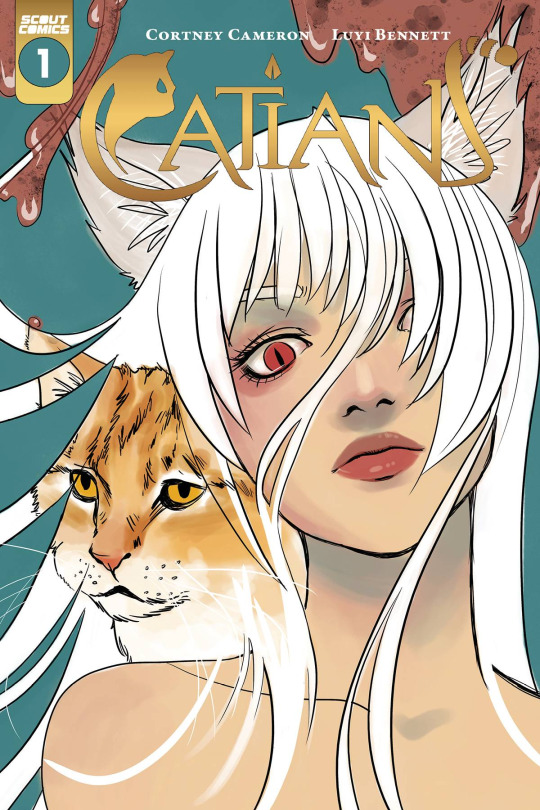
Catians #1 - Cortney Cameron & Luyi Bennett
Stray cat Felix leads a happy life skimming milk from his human friend Rose's convenient store, until the local protection racket turns violent. To save Rose's life, Felix breaks his vows and shares an ancient secret. Unfortunately, Rose uses her newfound knowledge to mix revenge and forbidden magic, unleashing a monstrous abomination that forces the mysterious Council of Cats to launch a global quest for the Relics of the divine Great Cat.

Deadpool: Seven Slaughters #1 - Rob Liefeld & Greg Capullo
Seven kills in seven days! Welcome to a week in the life of Wade Wilson, the best mercenary Marvel's ever had (just ask him)! From facing off with rival killers to top secret assassinations, DEADPOOL has a lot of work to do in this blood-soaked oversized issue full of fan-favorite creators past and future!
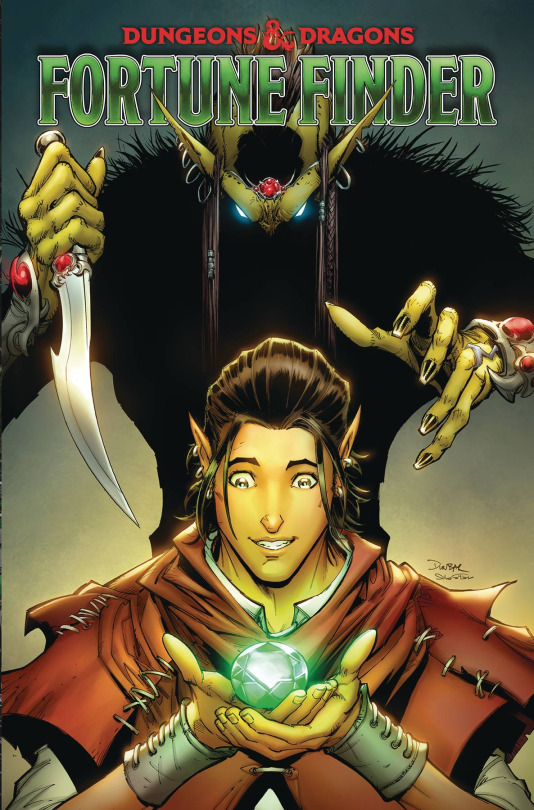
Dungeons & Dragons: Fortune Finder #1 - Jim Zub, Joe Jaro & Max Dunbar
In the city of Sigil, an amnesiac hero only known as "Finder" tries to uncover who they are and why they're being chased by planar beings intent on capturing them-or worse. But as their tumultuous journey unfolds, they discover that their fate is tied to grand forces that dictate reality itself throughout the planes! A shocking surprise lurks around every corner in FortuneFinder, a miniseries inspired by the new Dungeons & Dragons sourcebook Planescape: Adventures in the Multiverse.
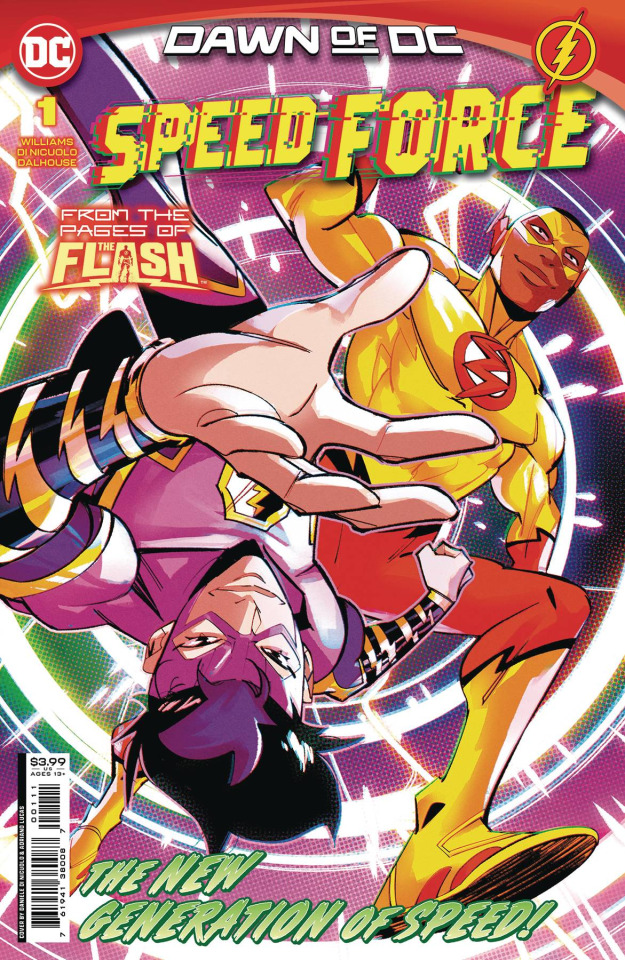
Speed Force #1 (of 6) - Jarrett Williams & Daniele Di Nicuolo
Wallace West and Avery Ho: the young speedsters have been Teen Titans, Justice Leaguers, and above all, members of the Flash Family. As they become aware of mysterious changes happening to the Speed Force, they race to Keystone City, where they encounter old friends, new threats, and a chance to forge their own paths.

Geiger: Ground Zero #1 (of 2) - Geoff Johns & Gary Frank
The saga of THE UNNAMED continues! GEOFF JOHNS and GARY FRANK return to the apocalyptic world of GEIGER for a special explosive two-issue origin epic.
What happened to Tariq Geiger in the days after the nuclear bombs first dropped? How did mankind survive the UNKNOWN WAR? Who is the mysterious Russian scientist Dr. Molotov and why is he hunting Geiger? And how does this tie all the way back to the American Revolution? Get ready to put on your hazmat suit and find out!

GI Joe: A Real American Hero One-Shot - Bob Mcleod & Herb Trimpe
Celebrate the return of G.I. JOE: A REAL AMERICAN HERO with the definitive edition of its historic first issue! This issue restores Larry Hama's original, unedited dialogue, which has never before seen print!

Godzilla Rivals VS Mechagodzilla #1 - Mark Martinez
IS YOUR CITY BESIEGED BY KAIJU? DO YOU LIE AWAKE AT NIGHT ANXIOUSLY LISTENING FOR THE MONSTER SIRENS? HAVE YOU HAD ALL YOU CAN TAKE OF GIANT LIZARDS, MOTHS, PTERODACTYLS, AND SHRIMP? THEN CALL TRACER TECH TODAY! OUR STATE-OF-THE-ART ANTI-KAIJU TECHNOLOGY HAS ALLOWED DOZENS OF CITIES AROUND THE WORLD TO FEND OFF THE THREAT OF MONSTER ATTACK.
San Palomar, California. It's a sleepy city with not much going on. That is, until Tracer Tech built their new corporate headquarters there, displacing lifelong citizens and forcing out local businesses. But what is the source of Tracer's amazing, almost alien technology, and why has it put San Palomar in Godzilla's sights? And what can a couple of local kids like Alex and Jaz do to protect their city when the King of the Monsters and its robot doppelgänger clash?
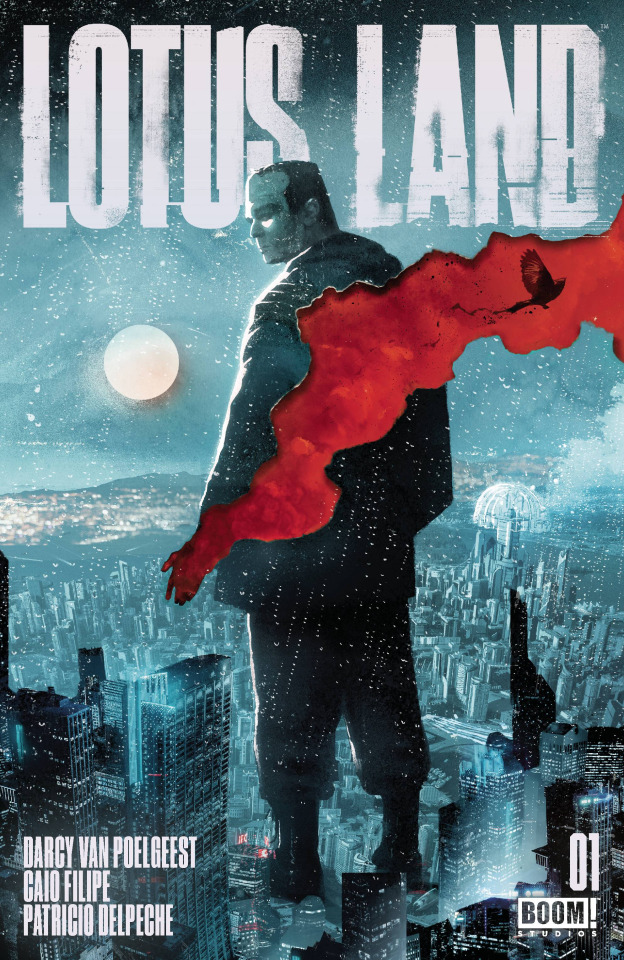
Lotus Land #1 (of 6) - Darcy Van Poelgeest, Caio Filipe & Alex Eckman-Lawn
In a Vancouver of the future painted with ultramodern decay, a groundbreaking advancement in technology promises an end to entropy itself.
But when an attack on this mysterious "Keeper Program" threatens the lives of everyone tied to it, retired Police Detective Bennie Strikman is called to investigate one last case.
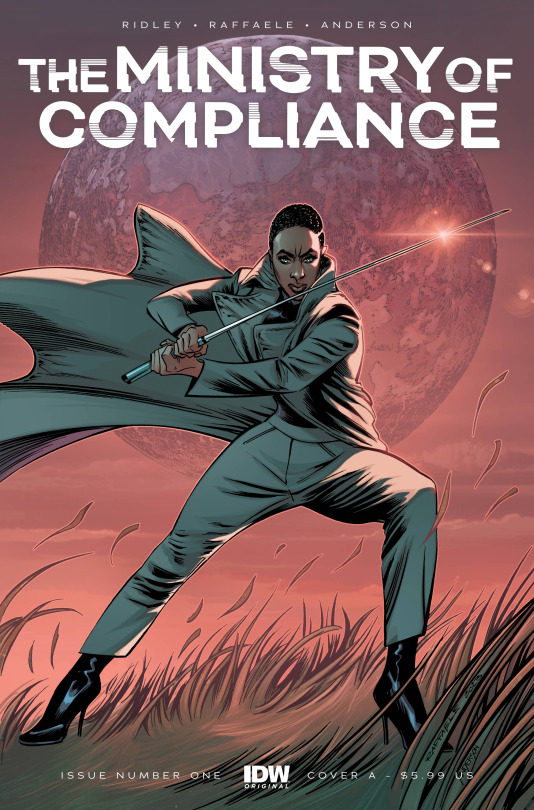
The Ministry Of Compliance #1 - John Ridley & Stefano Raffaele
Thirty-seven years ago, Earth was secretly invaded by an alien force known as the Devolution, and they have been shaping the direction humanity has been going in ever since to prepare us to be assimilated into their empire.
The Devolution has thirteen ministries, each responsible for manipulating a different aspect of human life. The Ministry of Compliance, the most feared of all the ministries, led by the fierce Avigail Senna, makes sure all the ministries stay in line and remain focused on the Devolution's mission. As it appears the Ministry's mission is on the verge of being completed and Earth will be assimilated, things begin to go terribly wrong, and a conspiracy among the ministries breaks out that Avigail must deal with head-on.
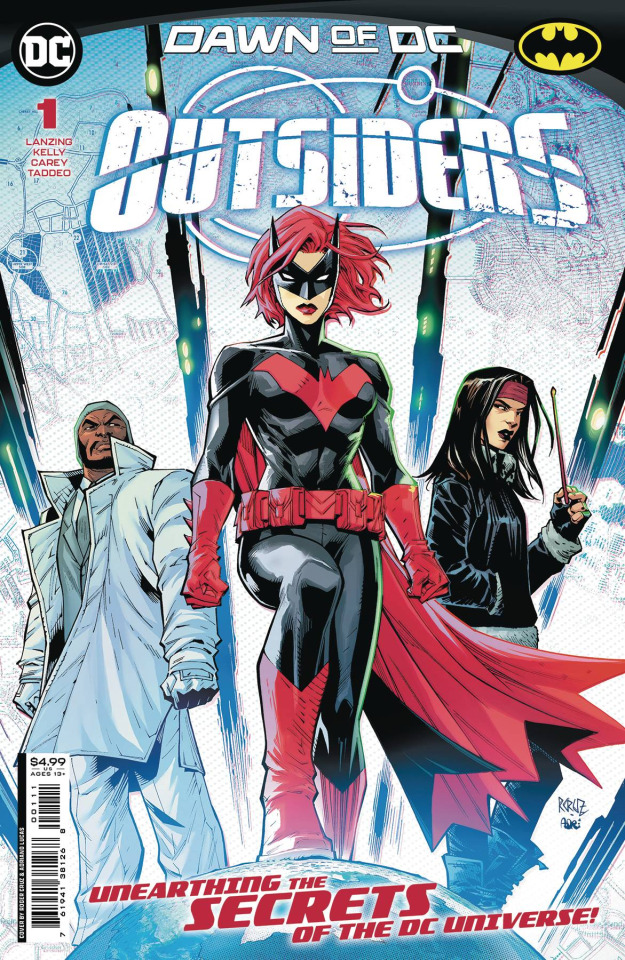
Outsiders #1 (of 12) - Jackson Lanzing, Collin Kelly & Robert Carey
Never the End. A universe of secrets is about to come to light. Batman protects Gotham City from evil. Batman Inc. protects the rest of the known world. But what of the unknown world? What of the ancient evils in hidden tombs and forgotten tragedies from a magic-and-mad-science fueled super-heroic century? Using his fortune, Luke Fox launches a new organization dedicated to shining light into the world's darkest corners. His first recruit: Kate Kane, the Batwoman--who will re-embrace her military background to protect Luke's dream and encounter every bit of strangeness the DCU has to offer. And just wait until you meet the Third Man...or learn what universe-shattering secret they've discovered buried under Antarctica. Outsiders is the return of comic book archaeology, digging into all the forgotten corners of DC's history to preserve, record, and better understand the true nature of the DC Multiverse...and the forgotten stories that make up its fabric.

Red Light #1 (of 4) - Sarah Cho, Priscilla Petraites & Jeff Dekal
Lacy is an A.I. sex worker in a futuristic Red Light District. And Lacy knows exactly what her clients want - better than they know it themselves. Housed in a high-tech brothel under the watchful eye of the mysterious Mister, Lacy has little in her manufactured life besides work. All that changes when she befriends Natalie, an orphaned child who comes into her care. Now Lacy and Natalie are on a mission to escape the Red Light District, only to find themselves flung headlong into the mystery behind Lacy's creation.

Superior Spider-Man #1 - Dan Slott & Mark Bagley
A Superior Reckoning! SPIDER-MAN faces a NEW VILLAIN from his SUPERIOR past. As she fries New York with all the power of a living star, DOC OCK makes a life-changing discovery! MARK BAGLEY and DAN SLOTT continue their Spider-Man run with this 10th-ANNIVERSARY celebration of everything that made Spider-Man Superior.

Street Fighter 6 Evolution Special #1 - Capcom, Matt Moylan, Hanzo Steinbach, Tovio Rogers, Jeffrey Chamba Cruz & Genzoman
The new era of fighting games continues with three short-stories starring six World Warriors! Featuring Rashid, Cammy, Dee Jay, Luke, Jamie, and the debut of an all-new Street Fighter 6 character.... the deadly A.K.I.!
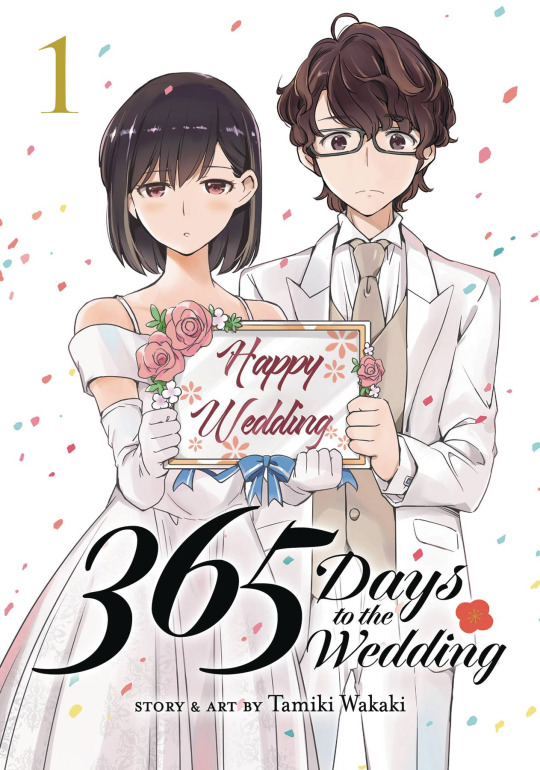
365 Days To The Wedding GN Vol 1 - Tamiki Wakaki
A sweet "fake engagement" romance about quiet coworkers by the creator of The World God Only Knows! The J.T.C. travel agency is looking for someone to manage its brand-new branch in Irkutsk. But for employees Oohara Takuya and Honjouji Rika, they'd rather just stay home in Tokyo! Thankfully, they've discovered a way out-their manager has narrowed down the recruits to bachelors, so what if they just... got married? The problem is they barely know each other at all! Can they convince their office they're engaged just long enough for the transfer to finish up?
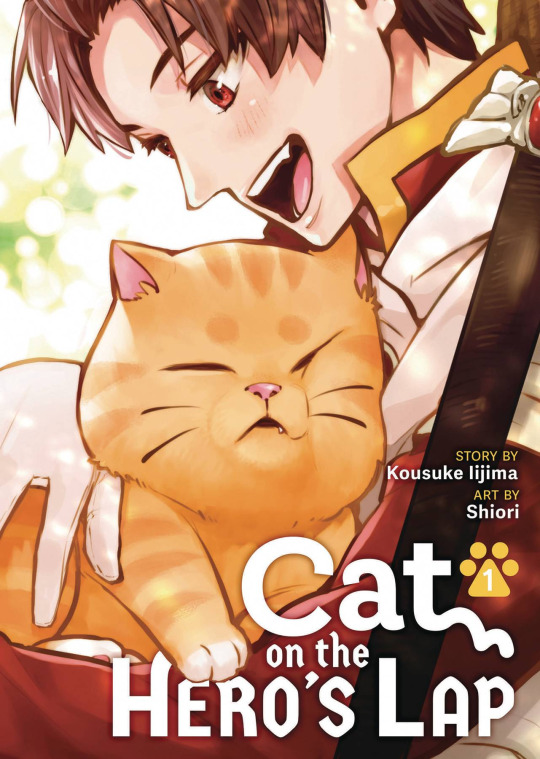
Cat On The Hero's Lap GN Vol 1 - Kosuke Iijima & Shiori
In this hilarious fantasy adventure, will the hero triumph against the evil demon king, or face defeat... because he can't fight with a cat on his lap?! Our brave hero, Red, has embarked alongside his companions on a journey to defeat the great demon king. Or at least, that was the plan. But then a cat sat on Red's lap and fell asleep. There's no way he can fight monsters like this! As it turns out, Red's greatest enemy is right on top of him!

Curses GN - George Wylesol
"Sometimes I think I see things. Out of the corner of my eye, behind a door, I catch a glimpse of something. It's like a curtain caught in the wind, and then it's gone." From hospitals to hell to the wilderness, George Wylesol's short stories take place in liminal spaces where nothing is as it seems; the surreal becomes real; and something is lying in wait around every corner. As our main characters navigate through corridors, passageways, and highways, they sink deeper and deeper into everyday strangeness that slips into peculiarity, creating an internal journey from normalcy to the supernatural.
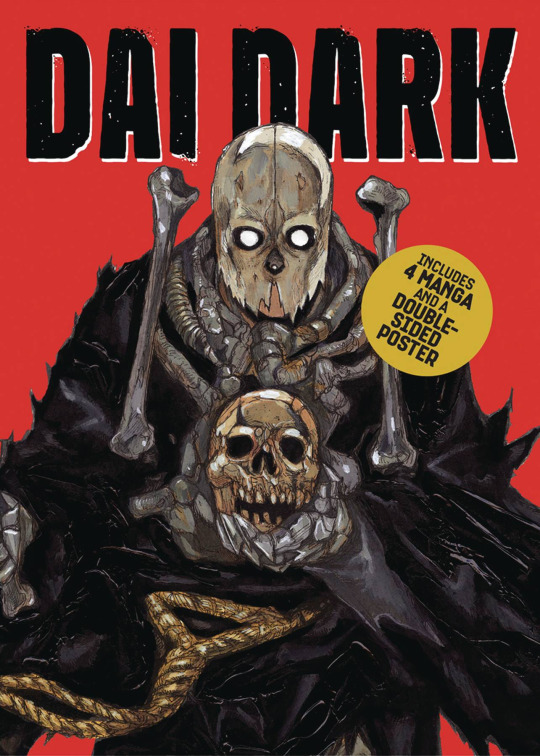
Dai Dark Box Set Vol 1 - Q. Hayashida
Introducing the first box set for this hilarious, gruesome, unforgettable tale where dark magic and space action collide! Zaha Sanko's body has great and terrible powers-they say that possessing his bones will grant you any wish, even the desire to become ruler of the universe. But Sanko is still a teenage dude with his own life, and he isn't about to let every monstrous lowlife in the galaxy rip him limb from limb. He and his skeletal buddy Avakian will use their dark powers to fend off any murder attempts while they search space for whomever put this curse on Sanko's bones... because killing them might end the madness. (And then Sanko can celebrate with his favorite spaghetti.) This beautiful box contains Vol. 1-4 of the manga and one double-sided poster.

The Dangerous Convenience Store GN Vol 1 - 945/gusao
This hit Boys' Love webtoon/manhwa (comic) is coming to print in English for the first time! Yeo Eui-joon needs cash, so he works part-time at a convenience store-where the clientele includes hoodlums and mobsters. He's tired of being yelled at while ringing up booze and trying to talk his way out of extortion, but he's not tired of seeing a certain good-looking gangster walk in the door. Gunwoo is huge, gruff, and intimidating at first... but he seems to care about Eui-joon's well-being, and is quick to knock aside anyone giving Eui-joon a hard time. After Eui-joon gets a peek at the enormous condom size Gunwoo buys, a little spark of attraction might just grow into a big, fiery love story!
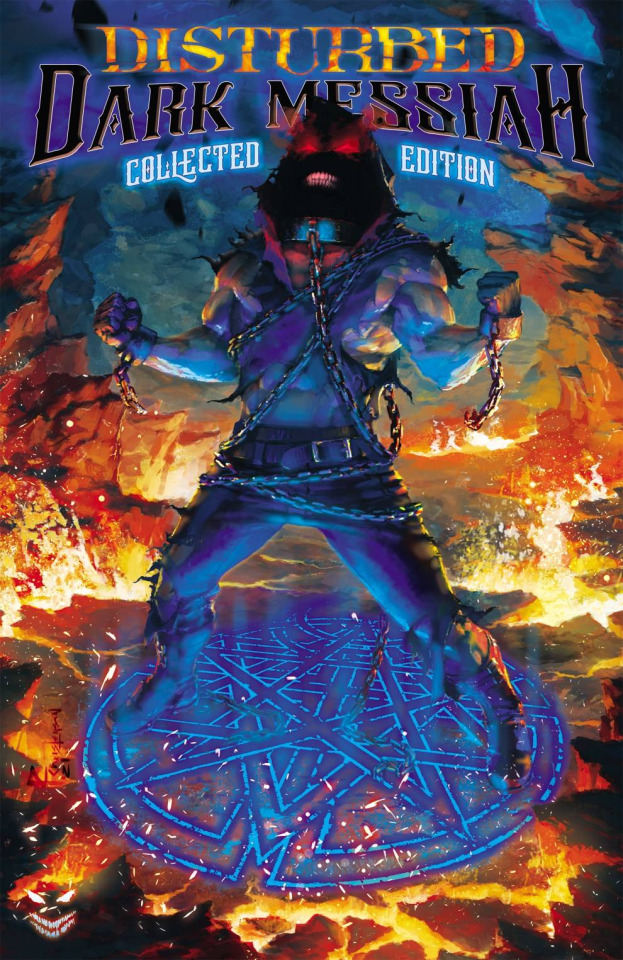
Disturbed: Dark Messiah TP - Tim Seeley, Angel Hernandez, Esau Escorza & Ryan Christensen
In the not so distant future, firefighter Griffin DeSanto has found himself a man out of time, stumbling into a harsh world of poverty, automation, and subjugation. Technology rules and a tech empire built on suffering keeps the population in check through surveillance and mechanized policing. Though lost, Griffin is never alone, he was brought here for a reason, and The Vengeful One is his guide.
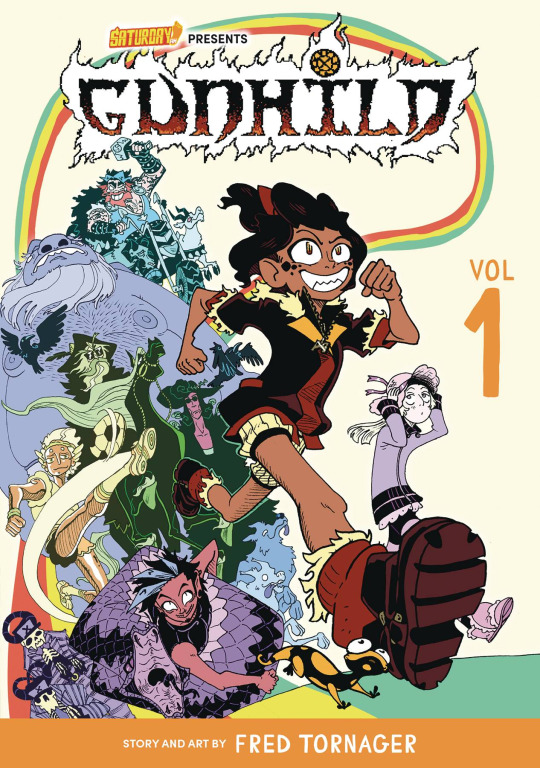
Gunhild GN Vol 1 - Fred Tornager
Her travels lead mainly to many foes, but a few enemies become friends, persuaded by Gunhild's unwavering determination and burning passion for her own cause. Being a tiny Jotun against a big, powerful world, Gunhild must fight smart and learn a trick or two from Loki to earn the title of godhood. Certainly, Gunhild will stop at nothing to forge her own fantastic path and make her dream come true.

The History Club HC Vol 1 - Bret Baier & Marvin Sianipar
From Bret Baier comes the first book in a thrilling new time-bending graphic novel series about kids who use their love of history to thwart an evil time traveler's scheme to change the past! Becca, Zack, Cam, and Thomas are best friends who may seem like an unlikely group on the surface but who have something very important in common: a love of history! Together, they make up their school's history club that has an all-important secret mission: stop the villainous History Twister's plot to destroy the past, forever altering the future. Knowledge of history is their superpower as they chase the Twister through time. After all, who knows what would have happened if Alexander Hamilton had lived and Aaron Burr had died in their infamous duel? It's up to the History Club to save the world from utter destruction!
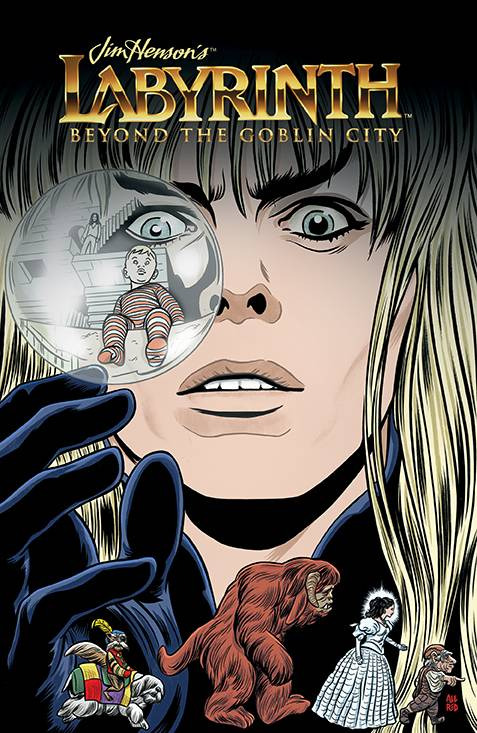
Jim Henson's Labyrinth: Beyond The Goblin City TP - Delilah S Dawson, Gustavo Duarte, Jeff Stokely, Ross Curry, Jonathan Case, Adam Smith, Lara Elena Donnelly, Sas Milledge, Daniel Bayliss, Pius Bak, French Carlomagno, Jeff Stokely, Kyla Vanderklugt, Samantha Dodge, Gustavo Duarte & Mike Allred
Featuring the secret history of Sir Didymus and the untold story of one of Jareth's Masquerade guests, in addition to stories featuring fan-favorite characters like Ludo, Hoggle, Sir Didymus, and the Goblin King himself.
This epic collection showcases imaginative tales from critically acclaimed writers and artists, including Jonathan Case (The New Deal), Delilah S. Dawson (Star Wars: Phasma), Gustavo Duarte (Bizarro), Roger Langridge (Snarked), Katie Cook (Star Wars: ABC-3PO), Jeff Stokely (The Ludocrats), S.M. Vidaurri (Labyrinth: Under the Spell), Sina Grace (Superman: Kal-El Returns), Michael Dialynas (Wynd), Sarah Webb (The Storyteller: Sirens), Boya Sun (5 Worlds), Lara Elena Donnelly (The Amberlough Dossier), French Carlomagno (The Dead Lucky), Pius Bak (Eat The Rich), Samantha Dodge (Catwoman: Soulstealer), and many more!
Collects Jim Henson's Labyrinth: Shortcuts and Jim Henson's Labyrinth: Under the Spell.

No Touching At All GN - Kou Yoneda
On the first day of his new job, the shy and introverted Shima suddenly finds himself trapped in an elevator with an extremely hungover man, who turns out to be none other than his new boss, Togawa. Though Shima is initially put-off by Togawa's rude and shameless behavior, he can't help but be drawn in by the man's compassionate side, and he soon finds his thoughts are completely consumed by the charismatic man. Unfortunately, painful experiences from his past continue to haunt Shima, and ultimately prevent him from taking the first step. Even when Togawa makes his feelings for the young man blatantly clear, despite also having agonizing memories and an unpleasant past of his own, Shima still hesitates to open himself up to the man. How will things turn out when a love is so obvious that it can felt, but the individuals in question can't express it directly?
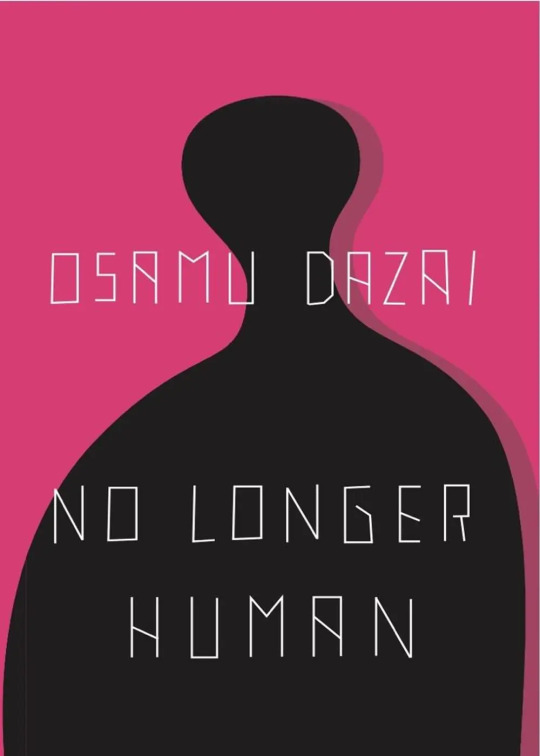
Osamu Dazai's No Longer Human GN - Osamu Dazai & Chika Ito
This manga version of novelist Osamu Dazai's masterpiece No Longer Human, the #2 bestselling novel of all time in Japan. Yozo Oba, a young man growing up in Japan in the immediate aftermath of World War II, is tormented by a failure to find any value in himself or in human relationships, despite being surrounded by women who love him. He creates the persona of a buffoon who mocks himself while entertaining others. But inside he is tortured, and as he moves from childhood to adulthood he becomes addicted to sex and alcohol. Largely autobiographical, No Longer Human explores Dazai's own sense of failure and alienation which drove him to self-destruct with alcohol and numerous suicide attempts.

Power Rangers Universe TP - Nicole Andelfinger, Simone Ragazzoni & Derrick Chew
WHAT IS THE TRUE ORIGIN OF THE PHANTOM RANGER?
On a journey across time and dimensional space, writer Nicole Andelfinger (Dragon Prince: Bloodmoon Huntress), artist Simone Ragazzoni (Odessa), and colorist Mattia Iacono answer the questions fans have been asking since the beginning!
A mysterious pod crashes to earth, while the Legendary Ranger Teens take on thrilling new forms, powerful against their foes and dangerous to themselves, and even contend with a corrupted former ally. Can they save their friend and protect the Morphin Grid from destruction?
Discover the truth behind the Phantom Ranger, the Morphin Masters, Power Rangers, and the Morphin Grid itself in the series that will unlock the secrets of the Power Rangers Universe!
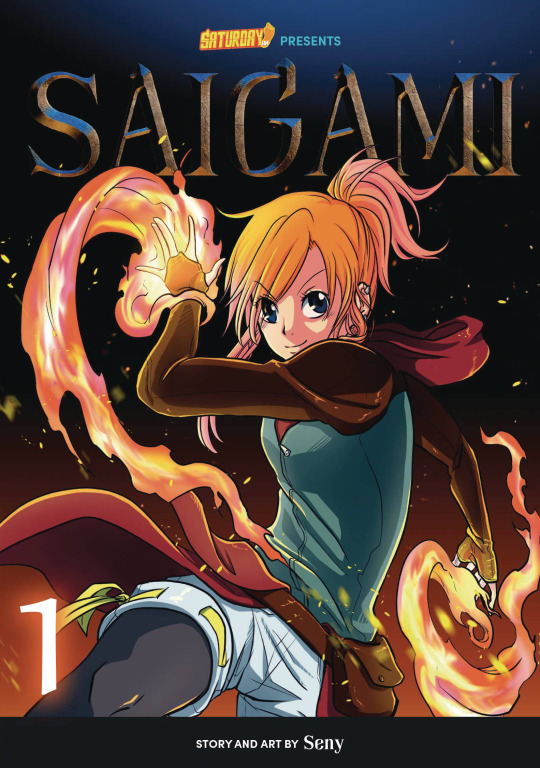
Saigami GN - Seny
The girl known as Ayumi is a troubled European teenager who feels lost, like a stranger in her world. Her father left when she was little, while her mother's work means she is never around. A love of manga and books keeps her happy, while honest-to-goodness friends seem to be something only other people have. But this is not the case in the fantasy land known as Aesztrea. In this strange new world, there are dragons, creatures, and warriors who can wield power beyond our wildest imagination. When Ayumi arrives in Aesztrea, she learns that she may also be a Saigami. This warrior class of supernatural and superhuman abilities is one of the most honored and respected people in this new world. For the first time in her life, her potential is limitless, and she has seemingly found a place and a people where she can belong. But not all is right in Aesztrea, Ayumi will have to face her own demons to get to the bottom of this and determine who she wants to be.

Sakura Saku GN Vol 1 - Io Sakisaka
Saku Fujigaya would like to thank the boy who helped her, but all she has is a note signed "Ryosuke Sakura." She discovers that a boy at her high school, Haruki Sakura, has an older brother named Ryosuke. She asks Haruki to deliver her thank-you letter to Ryosuke, but why does he refuse?
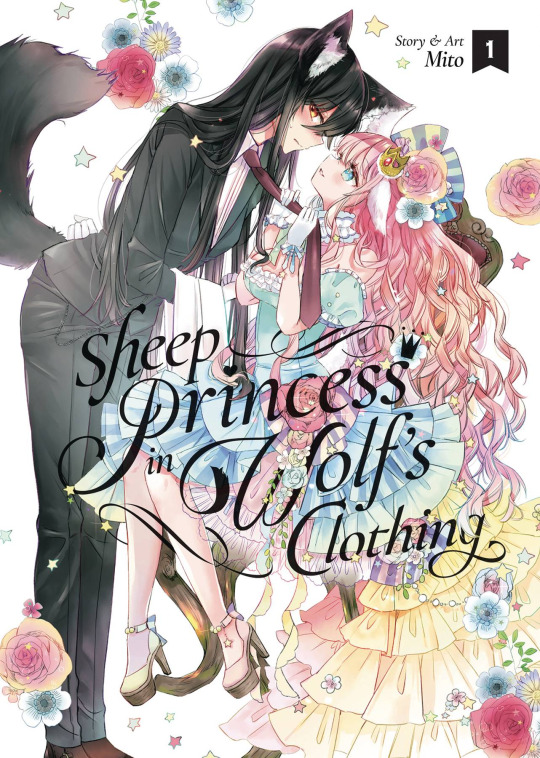
Sheep Princess In Wolf's Clothing GN - Mito
In this beautifully illustrated yuri/Girls' Love fairy tale, a wolf-woman butler must tutor a sheep princess who's not as soft as she looks! Aki Rikujo, a Wolfa, works as a butler at the royal castle in the land of Sheepa. Her quiet and peaceful days get shaken up when she saves the life of Princess Momo Shiudafaris. The shy sheep princess immediately latches onto Aki who, before she knows it, becomes the princess's private tutor. Momo wants more than just math lessons from Aki, and even sneaks into the wolf-woman's bedroom to seduce her! Aki soon realizes that, under the timid woolly exterior, Momo is a wild animal!
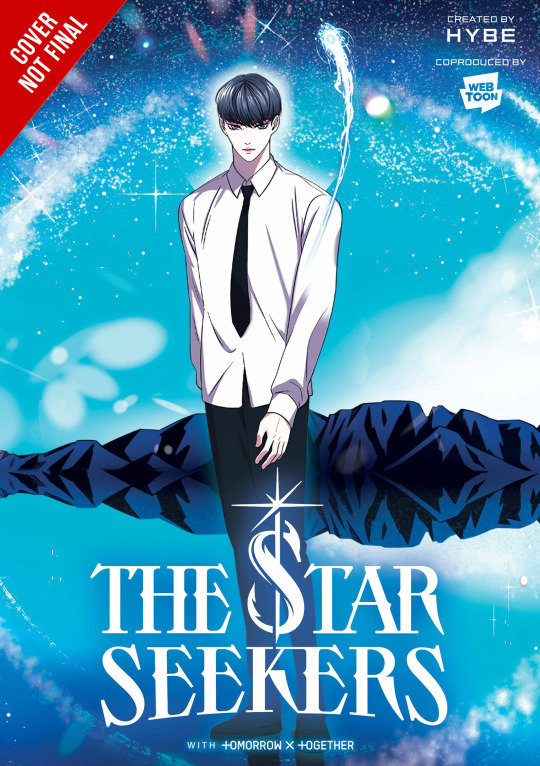
The Star Seekers GN - HYBE & Tomorrow X Together
When assailants interrupt Star One's comeback stage, the boys spring into action...all except Eugene! Though he helps as best he can, his lack of magic limits what he can do. That is, until the strange stray cat he picked up appears in a flash of light and offers him power...
Whatcha snaggin' this week, Fantom Fam?
11 notes
·
View notes
Note
Who are the loony left and the loony right?
Sunny: oh this is gonna be fun. So, we should probably start with some context - there was a lot of self-sorting during the Polycrisis and we’re still living with the downstream effects of that in 2069.
Maria: And it wasn’t just an urban coasts vs rural interior thing. There were a lot of digital communities that became face-to-face communities.
Sunny: Yeah. It was kind of the silver lining to all of this. The coasts were fine, everyone knew the coasts would be fine, they still had people keeping the lights on, but in the interior it was just YOYO - that’s an acronym for You’re On Your Own - and there were some people who were really into that. If you didn’t like your life then you could just move with your internet friends to some ruins in Montana or whatever and start over.
Jacob: neo-carpetbagging, baby!
Maria: Yeah, but the odds weren’t great. The textbooks like to portray it as this brave new world, like a Thirteen Colonies redux, but it was more like… you flip a coin, if it’s heads then your new community turns into a sex cult, if it’s tails you die from contaminated water or get shot over a petty dispute, and if the coin lands on its side then you start some rural industry like brewing or beekeeping that’s boring and profitable enough to form a stable business and cover basic maintenance costs. So it really was like the Thirteen Colonies in that sense.
Jacob: Yeah, all the successful Kowloons - that’s the nickname for these frontier towns by the way, Kowloons - the successful ones were all, like, hipster company towns.
Maria: They’re not that bad. Not anymore, at least. Sorry, what was the question?
Sunny: loony left and loony right.
Maria: okay, yes. Point being, “the ideological became geographic,” as the saying goes. So, do we wanna do right or left first?
Jacob: We kinda just did. The loony left formed sex cults and the loony right shot each other over property disputes.
Sunny: there’s so much more we could talk about, though. Like the Suburban Samurai. So, in eastern America you’ve got the Boswash megalopolis on one side, you’ve got the Great Lakes Republic on the other-
Jacob: that’s me!
Sunny: -and in between it’s one big exurb full of Suburban Samurai: rentiers, small business manor-lords, get-off-my-property types… Neo New Hampshire people, basically.
Jacob: Yeah, they’re all the chuds who think they’re Charles Martel protecting their local Denny’s from Chinese invasion.
Maria: Really? I thought you would’ve liked the Suburban Samurai.
Jacob: Why the hell would I?
Maria: Because you live on a manse and dress like an 18th century cavalry officer.
Jacob: Ahem, just because I live on a vast estate with a fleet of cross-dressing servants doesn’t mean I’m not a socialist.
Sunny: the word ‘socialist’ has pretty much lost all meaning now, if that didn’t tell you already. Shall we do the loony left now?
Maria: excuse me, I think we’re forgetting something.
Jacob: oh I know where this is going.
Sunny: folks, it’s gonna get weird for a minute.
Maria: the Suburban Samurai pale in comparison to my sworn nemesis, Tidewater. The wrong side of the Appalachian mountains.
Jacob: ‘sworn nemesis,’ they’re literally on the other side of the continent.
Maria: and they’re still too close! Ladies and gentlemen, I will not rest until every last bastion of Southern perfidy has been erased from America! Dixie delenda est!
Sunny: Maria. No purges.
Maria: but how do know they don’t work if we’ve never even tried it?
[the next four minutes and twenty-three seconds have been edited from the recording]
Maria: Ahh… mommy has her gin now.
Sunny: So, the loony left!
Jacob: Slimmer pickings here. There’s a lot of off-the-grid types on the interior side of the Rockies.
Sunny: god, yeah, they’re all “but I don’t want the Global Logistics Network to track my location. The president shouldn’t be able to hijack my electronic devices whenever she wants, waaaaah.”
Jacob: what else… Maria, is Juche Cascadia still around?
Maria: Sort of. I let ‘em keep a little corner… like a zoo. *tipsy giggles* My own little open-air zoo of Maoist Third-Worldists.
Sunny: I’m stopping this before it gets weird again.
Jacob: too late.
Sunny: that’s all the time we have for today, folks!
#manorpunk#unreality#sunny roosevelt#jacob martin rider#maria von zuckerberg lorraine#thanks for the ask!#q and a
12 notes
·
View notes
Text
How Digital Marketing Services Can Help Small Businesses Compete with Giants
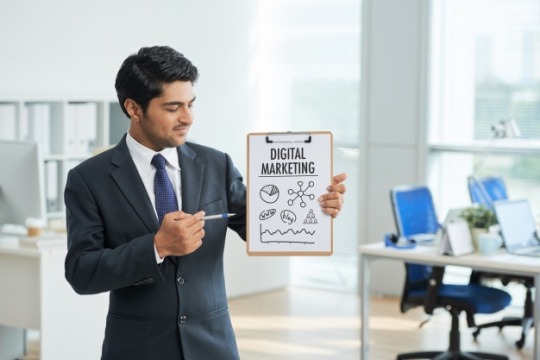
Hey there, small business owners! We know the pain of trying to keep up with the big players in your industry. It can feel like David vs. Goliath. But guess what? You've got a secret weapon – Digital Marketing Services! Let's dive into how they can level the playing field and help you compete with the giants.
1. Online Visibility Boost
Digital marketing services help small businesses be seen on the web. From crafting a killer website to optimizing it for search engines (SEO), these services ensure you show up when potential customers search for products or services in your niche. Mgadz can help you with their local SEO services in Brampton.
2. Targeted Advertising
Ever heard of "pay-per-click" (PPC) advertising? It's like magic for small businesses. You only pay when someone clicks on your ad. Plus, you can precisely target your audience based on location, interests, and behavior, ensuring your ads reach the right people. If you want to learn more about PPC, get in touch with experts at Mgadz.
3. Social Media Mastery
The giants have a huge presence on social media, but that doesn't mean you can't join the party. Digital marketing services help you create engaging social media content and run effective ad campaigns. They help you get noticed by your ideal customers.
4. Content is King
Small businesses can shine with killer content marketing. From blog posts to videos, you can establish yourself as an expert in your field. Digital marketing services can help create and distribute high-quality content that resonates with your audience.
5. Email Marketing
Don't underestimate the power of your email list. Digital marketing services can help you build and nurture your email subscribers. It's a cost-effective way to stay in touch with your customers and keep them coming back for more.
6. Data-Driven Decisions
One of the coolest things about digital marketing is the data you can collect. You get insights into what's working and what's not. This helps you refine your strategies and make smarter decisions to outperform the giants. You get data for Google Ads through its Analytics platform. For Meta, their is Meta business suite.
7. Budget-Friendly
Digital marketing services can be tailored to your budget. You don't need deep pockets to get started. You can start small and scale up as you see results.
8. Compete Locally and Globally
With digital marketing, you can compete locally and even on a global scale. Whether you have a physical store or an online shop, digital marketing can help you reach the right people, wherever they are.
So, there you have it! Digital marketing services are your secret weapon to compete with the giants in your industry. They offer cost-effective strategies, targeted advertising, and a wealth of data to help you stand out and grow your business.
At Mgadz, we specialize in providing top-notch digital marketing services in Brampton tailored to small businesses like yours. Our friendly team is here to help you every step of the way. Don't let the giants intimidate you – let's work together to make your business thrive in the digital world. Contact us today and let's get started on your path to success with digital marketing services!
#digital marketing services#SEO#seo services#affordable seo agency#digital marketing agency#digital marketing agency Brampton
2 notes
·
View notes
Text
Day Ten
Today's subtitle: Me VS Technology.
In APGOV, I did battle with my printer (I lost, but then the tech people got me a new one), and then I did battle with the photocopier. It almost defeated me, but I undid all the paper jams someone else had caused, and got what I needed- namely, an article about how local governments in NH are run, which students read and then discussed with me. After they came back from lunch, we watched an old video clip in which a boy is writing a letter to describe this region of the state to a foreign pen pal. Over the next few classes, my students will have to write a letter or film a video to explain life in their town, including a description on the major businesses, the school, the way the local government works, some major local issues. I first did this project on a whim last spring, and it went really well, so it's becoming a fixture in my curriculum.
In Global Studies I taught a lesson that required students to be on their chromebooks, so I had to compete with their screens for their attention, and... mostly won? They've been reading about the links between conflict and climate change, so I had them research some information about the civil war in Yemen because it's a great example of those links. We looked up a couple pieces of information together- me projecting what I was doing up on screen, them copying me- and I showed them how to use the Google Docs citation tool so they could properly cite it. Then I had them try it on their own. Anyone who was listening did fine, anyone who was not... did not. But I think a few of the students who found themselves struggling learned a lesson from it.
What else?
I haven't written much about my advisory yet this year. It's alright, but students either keep to themselves or their small friend groups, they're not much of a cohesive community yet. Still figuring out what to do about that...
#teaching#teacher#teachblr#edublr#education#technological mishaps#high school#social studies#day ten
4 notes
·
View notes
Text
Local vs Global Economy (and why anti-fa breaks glass)
Just like variables in programming, scope matters. The goal of the local economy is to take in value and circulate it. While the global economy takes value from locales and spreads it.
When a local economy gets too much currency, local prices inflated higher than the surrounding areas, in order to lower prices, a city needs to get rid of the currency. Either through imports, or outside labor.
When a local economy gets too little currency, there's not enough for growth and innovation. And that's where exports and tourism come in.
So why does anti-fa purposefully hurt local businesses? Because they can't afford it, it's likely the local businesses can't afford it, and lowering the GDP makes living affordable for local residents.
I didn't say they do it purposefully, or smartly. So don't @ me. Just listen.
By scaring off foreign investors, tourism, and exports. What remains is a lowered cost, so that locals can better afford and sustain livability. It's pretty much the same reason why the pandemic should have helped large pop cities afford food.
It also spreads out foreign investment, tourism, and exports to areas that are already low-pop sparse. Making those economies look more enticing, which can set the ball of gentrification in motion.
It's Better to be robbed where getting robbed is a loss of pocket change than a loss of a mortgage.
Now, that also means that there's a point where over-gentrification, over development, and over export can happen. And that is the tipping point that causes hyper-inflation.
What gums up the works is two fold: anti-gentrification (which seeks to preserve historical buildings, and often causes inflation on "local culture identity", and over-gentrification, which seeks to push out local residents for people that can pay more. (Instead of just paying local residents a living wage.)
And corporate America and bigbank both know that is how it works, and takes advantage of the disparity on purpose. Or maybe they don't, and they just ensured to situate themselves as the winner when either side borrows.
2 notes
·
View notes
Text
Traditional Marketing vs Digital Marketing: Which One Is Right for Your Business?
Introduction
According to the Best Digital Marketing Company In Pune now day’s businesses are constantly exploring various marketing strategies to promote their products and services effectively. Traditional marketing and digital marketing are two primary approaches that companies can adopt to reach their target audience. This article aims to provide an SEO-friendly guide comparing traditional marketing and digital marketing, helping you determine the right approach for your business.
Traditional Marketing:
Traditional marketing refers to conventional advertising channels that have been around for decades. These include print media (newspapers, magazines), broadcast media (television, radio), billboards, direct mail, and event sponsorships. Traditional marketing relies on physical presence and engages with consumers in the real world.
Pros of Traditional Marketing
Tangible Presence: Traditional marketing offers a physical presence that consumers can experience and remember, creating a lasting impression.
Local Targeting: Traditional methods allow businesses to target specific local audiences effectively, making it ideal for small businesses with geographically defined customer bases.
Established Trust: Over time, traditional marketing channels have built consumer trust and credibility.
Cons of Traditional Marketing:
High Costs: Traditional marketing campaigns often require significant financial investments, especially for television or print advertisements.
Limited Analytics: Measuring the effectiveness of traditional campaigns can be challenging, making it difficult to track the return on investment (ROI) accurately.
Lack of Interactivity: Traditional marketing channels offer limited opportunities for two-way communication with consumers, inhibiting engagement and real-time feedback.
Digital Marketing:
Digital marketing encompasses a wide range of strategies that utilize online platforms and channels to promote products or services. This includes search engine optimization (SEO), social media marketing, content marketing, email marketing, pay-per-click (PPC) advertising, and more. Digital marketing enables businesses to connect with a global audience, engage in real-time interactions, and measure campaign performance with precision.
Pros of Digital Marketing:
Wider Reach: Digital marketing allows businesses to reach a broader audience, transcending geographical boundaries and targeting specific demographics or interests.
Cost-Effective: Digital marketing methods often require lower budgets compared to traditional marketing, making it accessible to businesses of all sizes.
Targeted Advertising: Online platforms offer advanced targeting options, enabling businesses to reach their ideal audience based on demographics, interests, and online behavior.
Real-Time Analytics: Digital marketing provides detailed analytics, allowing businesses to measure the success of their campaigns, track website traffic, and make data-driven decisions.
Interactivity and Engagement: Digital marketing channels offer interactive features such as comments, likes, shares, and direct messaging, fostering engagement and building relationships with consumers.
Cons of Digital Marketing:
Constant Updates: Digital marketing strategies require staying updated with ever-changing algorithms, platforms, and trends, demanding continuous learning and adaptation.
Potential Information Overload: With a vast amount of digital content available, capturing and maintaining consumer attention can be challenging.
Determining What's Right for Your Business: When deciding between traditional marketing and digital marketing, consider the following factors:
Target Audience: Understand your audience's preferences, online behavior, and demographics to determine which approach will effectively reach and engage them.
Budget: Assess your available marketing budget and consider the cost-effectiveness of traditional and digital marketing channels.
Industry and Competition: Research industry-specific marketing trends and analyze how your competitors are reaching their target audience.
Business Goals: Align your marketing strategy with your business objectives, whether it's increasing brand awareness, generating leads, or driving online sales.
Conclusion:
Choosing between traditional marketing and digital marketing depends on your business's unique needs, target audience, budget, and objectives. While traditional marketing offers a tangible presence and local targeting, digital marketing provides a wider reach, real-time analytics, and interactive engagement. In many cases, a combination of both approaches can yield optimal results. By understanding the advantages of each and tailoring your marketing strategy accordingly, you can position your business for success in the digital era.
#Best Digital Marketing Company in Pune#Best Social media marketing company in Pune#seo services company#Best Social Media Marketing Agency#Digital Marketing Company In India#Digital Marketing Agency#Traditional Marketing vs Digital Marketing
2 notes
·
View notes
Text
Suburbs vs. Dense Urban Areas
I've never seen the appeal of suburbs as someone who's in the U.S. You have to drive everywhere using a car that is more than likely to be a little more than a decade old (recent studies have shown that the average age for a car in the U.S is around 10-13 years). There's not much diversity in terms of shopping or recreation besides a select few corporate stores with giant parking lots or small green areas sparsely sprinkled across tracts of giant roads and parking lots. It all feels ugly in some way, disorganized and unplanned. I like the more intimate setting of a dense city like NYC. I've visited multiple times in my childhood, and I can say that while it's not perfect in any way and has many issues in regard to its current aggressive and corrupt police force as well as homelessness and political corruption (though that's everywhere in America now isn't it), it is loads more magical and organized, with small businesses and local eateries with outdoor seating and walkable streets abundantly placed to convenience the city pedestrian, all the while taking up as little space as possible. Instead of large square mileage with no substance besides rows upon rows of cookie cutter homes and giant retail outlets and fast food, there's monuments, museums, libraries, etc., all in a walkable distance from an apartment or rowhome (depending on the city).
Source for average age of cars: Average Age of Vehicles in the US Increases to 12.2 years, according to S&P Global Mobility | S&P Global (spglobal.com)
3 notes
·
View notes
Text
Digital Marketing Vs Traditional Marketing

What distinguishes digital marketing from conventional marketing, and which should you use? Every marketer has thought about choosing the appropriate marketing type for a very long time. Here is all the information you require.
a comparison between traditional and digital marketing strategies Image courtesy of OrangeCrush
Simply put, digital marketing is the use of online platforms like websites and social media as instruments for marketing communication.
If you use social media, you are likely familiar with the advertisements that appear in your stream; this is digital marketing.
Traditional marketing: What is it? — On the other hand, traditional marketing uses conventional platforms like printed media and billboards. Imagine Don Draper from Mad Men coming up with Coca-Cola TV commercial concepts and copy for coca-cola
Pros and Cons Of A Digital Marketing Strategy
Digital marketing has its perks. However, there are a few disadvantages to this type of marketing that we will also consider in this section.
Digital Marketing Strategies Pros
Below are some of the advantages of digital marketing that marketers worldwide can relate to.
A. It makes it a lot easier to reach a global audience
Digital marketing strategies help you reach a global target audience. For example, when you create a website, it is not limited to your locality. Everyone that’s using the internet can access the information on that site. The same goes for social media marketing.
B. Results are Measurable
Whether you’re running social media ads or search engine marketing, digital marketing allows you to easily determine how many people clicked on your ad by using a few metrics. Unlike billboard and magazine ads where you can’t tell how many people saw them.
C. Personalized Ads
Digital advertising has made it effortless to contact consumers on a more personal level unlike the traditional media that creates ads on a more general basis. By clicking on a few links on the website, businesses can target a customer in real-time, calling them by name.
D. It is cost-effective
Unlike traditional marketing methods, meeting your target audience where they are will no longer cost you a hunk of your capital. Digital marketing allows you to create several campaigns at a very cost-effective rate.
E. Building interaction
Internet marketing is the easiest way to interact with your target audience anytime, any day. By frequently posting content on social media, you can get the reactions and feelings of your consumers about your product or service.
F. Higher conversion
Digital and traditional marketing will boost conversion. However, one does it better than the other. Your digital marketing efforts are very much more liable to bring in customers because the majority of your potential customers are online.
With digital marketing, you can meet them where they are and with just a few clicks, they can buy the product before they even know it.
G. It doesn’t take your time
Although building your brand online can take a while, just like any type of marketing, advertising online doesn’t require too much time or physical effort.
Cons of digital marketing strategies
Below are some of the disadvantages of digital marketing.
A. It requires a lot of experience
To be able to carry out a digital marketing strategy successfully, you need to be very experienced in all the different aspects of digital marketing mentioned above. Well, that is why you could simply hand the job over to a digital marketing company.
B. Visible complaints and negative feedback
One of the ills of digital marketing is the fact that your target audience can see what other users have to say about your product or service—bad or good. This can be a blessing or a curse, depending on the quality of your product or service.
C. Competitiveness
Online marketing is inarguably the order of the day. Every company has a social media account, a website, and most likely, a digital marketing company to handle these tasks for them.
This makes digital marketing very competitive. Your audience is very likely going to be seeing your competitors as much as they see you.
D. Privacy issues
With online marketing, you need to be very careful how you use the information of consumers. You have to be careful not to breach their privacy or security terms.
Traditional marketing vs. Digital marketing: what is traditional marketing?

Traditional marketing is any marketing activity or effort that is done offline. It is the only form of marketing that was done before the internet and social media became a huge part of our existence. However, traditional marketing is still highly in use.
Traditional marketing strategies involve the use of channels like prints, magazines, billboards, television, direct mail, and radio ads for interacting with customers and potential customers. It needs to be mentioned that over 40% of direct mail never gets opened.
Traditional marketing is difficult to ignore. It is always in your face. It comes in form of TV commercials that you cannot skip. If you must watch your program, then you must watch the ad.
The traditional marketing strategy makes use of the four Ps of marketing, which includes the following:
1. Product
Traditional and digital marketing focus on products and services. However, traditional marketing takes it up a notch by getting feedback from customers about the product and ensuring that it meets the request of customers. Digital marketing doesn’t pay attention to this. It focuses solely on advertising and selling.
In traditional marketing, the product has to be presented in a way that is palatable and solves the problem of the end-user. Everything from the packaging to branding and just about anything that makes the product more appealing to the user is focused on.
2. Price
How much do we set the price at? How much do our competitors charge for this product or service? Will we make any profit by bringing down the price to drag in customers? Will we get any customers by taking the price up? Can we sell at the same price even though our brand is better? All these are questions that go into the determination of price.
Traditional marketing strategy carries price along with the product and it is not a coincidence that “pricing” is very often placed after “product” when talking about the 4 Ps.
3. Promotion
Promotion is where traditional and digital marketing has almost everything in common. The promotion has to do with every activity that helps the brand get more recognition and also helps the company make more sales.
Traditional marketing will use radio and tv commercials, one on one advertising, billboards, and several other means to promote the product. Promotion doesn’t end at advertising. Discounts, gifts, and other strategies that help customers interact with the brand also count.
4. Place
The place in traditional marketing simply refers to the location of the business—headquarters or branch.
How do we situate the office or factory in such a way that we’re able to meet our customers at the point of their needs? Where do we set up the farm so that we can easily access the market for sales? These questions and more are what “Place” in traditional marketing tackles.
The Pros and Cons of Traditional Marketing
Traditional marketing has made its mark on marketing in general and will continue to do so. One question we very often get when talking about digital marketing vs. traditional marketing is whether one will outlast or terminate the other. Let us consider the pros and cons before we go into that.
Traditional Marketing Strategy Pros
Below are some of the important advantages of traditional marketing.
Establishes credibility: When you see advertising on TV, there’s a very high chance that you automatically think the company is a legit one.
Creates an easier connection with a local audience: When you create a marketing campaign on a radio station, you know you’re only relating with potential customers in that locality. It helps you channel your marketing campaigns more creatively.
It’s better for connecting to a larger and broader audience: One of the advantages of digital marketing over traditional marketing is that you can target an audience based on specific demographics. However, for brands that cater to more general audiences, traditional marketing helps you do that with ease.
Helps you connect emotionally: Traditional marketing allows you to communicate more emotionally to your audience, giving you room to connect more with them.
Traditional Marketing Strategy Cons
When it comes to a more modern and broader picture of marketing, the traditional way is at a disadvantage. Let’s take a look at the few cons of this form of marketing.
It is often more expensive: running a traditional marketing campaign requires so much funding. When you add the media buy and the total cost of production (+ marketing costs), you’ll see that it costs a lot to keep it running. According to Fit Small Business, the cost of running a full-page print ad can cost anywhere from $2,700 to $160,000.
The results are difficult to measure: when it comes to digital marketing vs. traditional marketing, one major deciding factor is how well these forms of marketing are doing. With traditional marketing, you cannot measure how many people interacted with your advertising campaign. How then do you know if it is worth paying for?
Most people don’t pay attention to the traditional media anymore. TVs and radios have not gone out of style but they are no longer as important as they used to be.
The traditional marketing campaign takes far too long to execute.
It is difficult to target a sub-segment audience.
How Does A Digital Marketing Strategy Differ From A Traditional Business Strategy?
The major differences between digital marketing, traditional marketing, and other types of marketing are the marketing channels and cost.
While digital marketing uses online tools and media, traditional marketing uses offline campaigns. You already know which one costs less and saves time.
Businesses that use digital marketing can reach their audiences much faster than traditional marketers because you don’t need to do
Another major difference between the two methods is that digital marketing allows you to only target an audience that has shown interest in your product or one that is interested in your industry.
You can see results in real-time with digital marketing. You know which variation of your audience is buying from you and which one may be interested but not yet ready to buy. This helps you to properly structure your campaigns.
Traditional Marketing vs Digital marketing
Deciding which one of these marketing methods to choose is not a difficult task, especially after reading through this piece of content.
Digital marketing, traditional marketing, or any other form of marketing has its good sides and not-so-good sides. However, when you consider which one has more good and less bad, you’ll know which one to choose.
From the carefully outlined advantages and disadvantages of both digital and traditional marketing mentioned above, it is obvious that digital marketing has a sharp edge over traditional methods.
Why’s that?
As of April 2021, more than 60% of the world’s population uses the internet in one way or the other. To clarify things, the world’s population is around eight (8) billion. This simply means that over half of the world’s population is on the internet doing one thing or the other.
Advertising to that population had to be the best marketing strategy ever, compared to sending direct mail, installing billboards, or using TV and radio ads.
One good thing, however, that most marketers will never tell you is that these two methods of marketing can work together to create the best campaign or strategy ever seen. This is because both methods give you access to both digital and traditional audiences.
Whether you like it or not, there will always be people who won’t and can’t use the internet. Kids, for example, influence their parents to make certain buying decisions.
Targeting this population has to be done through marketing channels where they can be met. TV shows for kids are a great place to do that.
Our advice is if you only have to choose one of digital and traditional marketing, then go digital. It is cost-effective and conversion is guaranteed, as long as you have an expert on the job.
Work With The Leading Cleveland Marketing Company

To achieve success in digital marketing, you need a highly experienced digital marketing company. It is very possible to do it alone, there’s no doubt about that. However, if you consider the time, effort, and cost of learning most of these skills, handing the task over to an expert is your best bet.
Work with the best Cleveland marketing company today and watch your business grow from where it is to where you want it to be in a matter of months.
We have been helping businesses maximize profits and boost sales. Our marketing strategy cuts across both traditional methods and digital methods.
We have a team of experts to handle all the different digital marketing channels, including social media, emails, search engines, website designs, and several others.
Conclusion
Traditional and digital marketing have proven to be important parts of the world of today’s businesses. You certainly cannot rule out the importance of one of these forms of marketing to favor the other.
Digital marketing can be referred to as the marketing method for the current world but that doesn’t rule out the fact that traditional marketing can complement its effectiveness.
Most of the time, marketers use traditional marketing to solidify the level of trust that consumers have in them and their digital campaigns.
2 notes
·
View notes
Text
Key Impact Investing Trends to Watch Out for in 2025: A Glimpse into the Asian Market
Impact investing is experiencing significant growth, particularly in Asia, where both institutional and individual investors are becoming increasingly active spurred by government support, which is playing a key role in fostering the development of the market.
Asia is deemed as the emerging impact investing giant, with heavy investments being made across sectors such as renewable energy, affordable housing and microfinance. There is a rising interest from both local and international investors in Asia aiming to achieve positive social and environmental outcomes alongside financial returns.
According to a recent report by GIIN, 68 Asia-focused investors managing over $38 billion USD in impact assets under management (AUM) found that 89% of them saw financial returns meeting or exceeding expectations. This underscores the accelerating momentum of the impact investing market, which is poised to grow even further in 2025.1
What Is Impact Investing ?
Impact investing refers to investments that aim to make a measurable social or environmental impact in addition to making a financial profit. Impact investing is, hence, different from traditional investments that are purely focused on financial returns. This method is being adopted more frequently around the world as economic growth and sustainability become more interconnected.
Investing can be classified as a spectrum ranging from pure philanthropy to traditional profit-driven investing. Impact investing occupies that middle ground, striving for financial profit as well as social and ecological returns.
Read more: ESG Risk Ratings vs ESG Impact Ratings
Types of Impact Investing
1) Green Investments: These investments target renewable energy, energy efficiency, and carbon-neutral technologies. The primary goal is to reduce greenhouse gas (GHG) emissions. Asia is now a substantial investor in solar, wind, and hydroelectric projects, as the region has become one of the largest emitters of GHG.
2) Social Impact Investments: These investment strategies address critical social issues such as education, healthcare, and gendered impacts. In Asia, the recent focus has been on microfinance projects and affordable healthcare programs. By leveraging SDG impact ratings, investors can better assess how these initiatives contribute to the United Nations’ Sustainable Development Goals (SDGs), ensuring their capital drives measurable, positive change in areas like quality education (SDG 4), good health and well-being (SDG 3), and gender equality (SDG 5).
3) Nature and Biodiversity Investments: Investments in this category aim at avenues such as natural ecosystem conservation, sustainable agriculture development, and biodiversity. Southeast Asia is a hotspot for international biodiversity investments because of its extensive resources. Due to the increasing global attention on deforestation, and ecosystem degradation and the risks emanating from them, nature and biodiversity investments are now crucial for investors. Governments and organizations are starting to implement stricter sustainability regulations alongside incentives for green investments.
4) Transition Investing: This investment method supports businesses and industries across their shift from traditional processes to sustainable methods. Transition investing focuses on the funding of companies, projects, or technologies which are shifting from a high-carbon, unsustainable business model to a low-carbon, sustainable one. It acknowledges that a lot of industries, especially some of the highest emitters, such as energy, transport, and manufacturing, have a longer timeframe for decarbonizing. This type of investing also recognizes that there is a need for supporting capital to help these industries achieve a structured, long-term transition.
5) Gender-lens Investing: Gender-lens investing focuses on investment in women’s entrepreneurship and businesses promoting women’s rights and opportunities. This form of investment addresses some of the structural discrimination that exists and helps develop the economy in a more balanced format, particularly in education and healthcare. Some interesting examples include:
Public Market Funds: Gender-diversity ETFs: SPDR SSGA Gender Diversity Index ETF, commonly referred to as SHE, is an exchange-traded fund that invests in public companies with extensive gender equity in their leadership roles.
Private Equity & Venture Capital: Gender-lens Funds: Beyond the Billion (BTB) is a consortium of venture capital funds that invest in women entrepreneurship-led businesses.
Key Impact Investing Trends Shaping the Asian market
1) Impact Investing Powered by AI and Technology
The development of artificial intelligence (AI) and machine learning (ML) technologies has significantly impacted the impact investing field through advanced data analysis and forecasting. Blockchain and other technologies make impact investing more robust by promoting tracking and accountability. In Asia, technology is being incorporated into agriculture, healthcare, and renewable energy. It fosters resource-efficient practices and provides timely project performance updates with assurance to the investors about their positive impact decisions.
2) Nature and Biodiversity Investments
There is a surge of investment in reforestation, mariculture, and sustainable agriculture as the world becomes more concerned about preserving biodiversity. Countries in Southeast Asia that possess some of the world’s richest biodiversity hotspots are receiving funding to mitigate deforestation and promote eco-tourism.
For instance, reforestation projects in Indonesia and Malaysia are gaining traction from private-public partnerships. Such investments are bound to help economic growth among the local population while enhancing environmental protection.
Read more: Impact of AI on ESG Assessment: What Asset Managers Need to Know
The Roadblocks and the Rewards: Navigating Impact Investing
The Challenges of Scaling Impact Investing
Impact Assessment: The measurement of social and environmental returns from investments is still a major challenge. Unlike financial returns, tangible results from initiatives in biodiversity or education sectors require complex systems and prolonged monitoring.For instance, assessing the changes in species populations as a measure of improvement in biodiversity is difficult and resource heavy. Likewise, assessing educational changes may require long-term data on performance and the resources available to them.
Regulatory Limitations: Differences in regulations for different countries in Asia present a complicated issue for cross-border investment and partnerships. Differences in what impact investing is and the compliance criteria for the same, affect investors greatly.
Conclusion
Impact investing has evolved into a significant industry from its original focus area. Developments such as AI adoption, biodiversity conservation, and transition investing capture the growing attention of the Asia Pacific region. Despite challenges like inconsistent regulations and greenwashing, the opportunities far outweigh the challenges posed.
The improvement in technology, enhanced collaboration, and focus on measurable results allow for the complete harnessing of the energy of impact ratings as a measurement tool. As social and environmental goals are increasingly supported by finance-based approaches, impact investing will certainly play a significant role in the global shift toward a sustainable future in 2025.
1 note
·
View note